 |
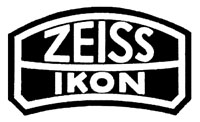
Zeiss was one of the most famous camera makers and is still a well-known producer of lenses. The company started as Carl Zeiss Jena in Dresden and was renamed Zeiss Ikon in 1926 after merging with several other camera makers. After WW II the company was split in an East-Germany part in Dresden and a West-German part in Stuttgart. Name disputes led to the Dresden part to be renamed VEB Pentacon. Lens manufacturing still continued as Carl Zeiss Jena and the company even made a range of cameras: the Werra. Zeiss Ikon stopped making cameras in 1972.
Icarette I (496)
Zeiss Ikon was formed in 1926 from the merger of several different camera companies in Dresden, one of which was Ica. Most if not all cameras that were in production by the original companies were listed in the Zeiss Ikon catalogue more or less in unchanged form, including the Icarette. The Icarette came in different versions, including a 6x9 format vertical folder and a 6x6 horizontal folder. The horizontal model came in two versions, a rollfilm version (model 495) and a rollfilm version which could be used with glass plates also (model 496). Both used 120 rollfilm, so can still easily be used today.
The Icarette was equipped with a frame finder, consisting of an 'eye piece', which doubled a latch to close the camera front, and a large metal wire. The camera also had a brilliant finder mounted on the shutter, which gave a small but bright image of the scene, albeit it mirrored left to right. Upon opening of the front door, the shutter-lens assembly had to be pulled forward until it would click in position. There were different stops for the use of rollfilm or photographic plates, as the latter were mounted further back than the rollfilm position. Focussing was down by moving the lens-shutter assembly forwards and backwards by means of a small lever.
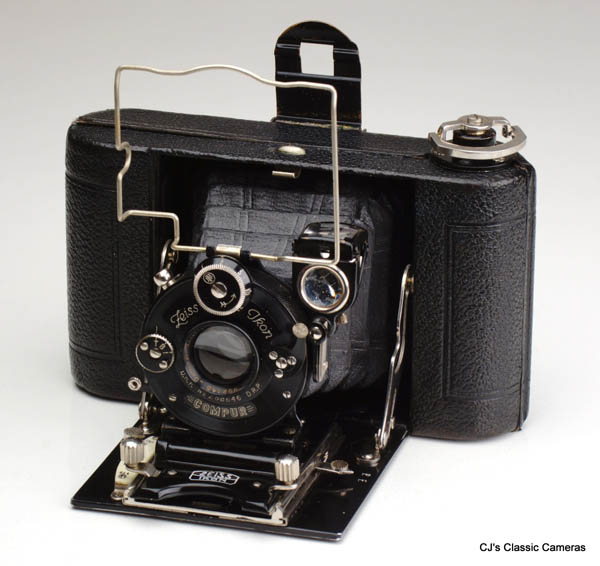
A 1926 Zeiss Ikon Icarette with Dominar Anastigmat 75mm f/4.5 lens in Compur dialset shutter. It was identical to its Ica predecessor, only the company name was changed.
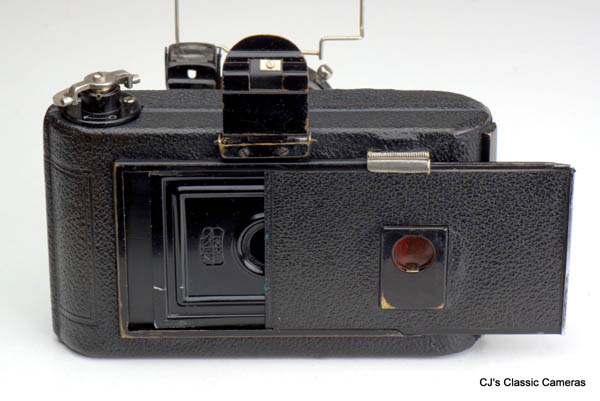
Rear view of the Icarette B showing the removable film plate cover. The plates had a rectangular film frame size of about 47x62 mm compared to the 57x57 mm square rollfilm format. The metal framefinder is not quite sqaure so seems to have been designed to match the film plates.
Soon after its initiation, Zeiss Ikon started streamlining their catalogue by removing old models from its founding companies and designing new ones. The Icarette could be found in Zeiss Ikon catalogues until the early 1930s but was then replaced by the Ikonta/Nettar line. The horizontal model appears to be rather rare and is much more commonly found as its Ica incarnation.
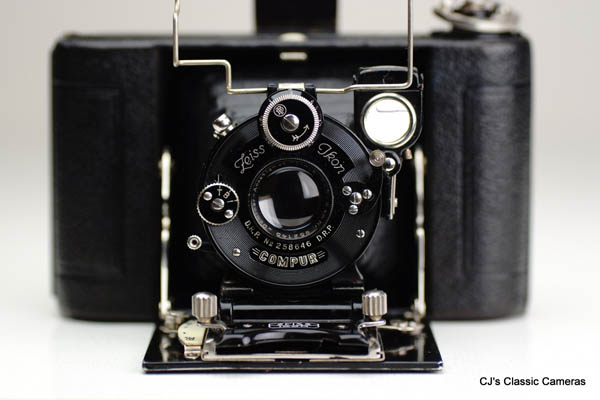
Detail of the Compur dialset shutter. Unlike the later rimset Compur models, which had a speedring to set shutter speeds, the dialset had a small wheel to select shutter speedsor, as well as a sepearate dial to select T and B modes. The number on the front of the shutter plate (D.R.P. No 258646) was not the shutter serial (which was engraved on the side) or model number, but a German patent number.
Super Ikonta C (530/2)
The Super Ikonta range was introduced in the early 1930s in several models for different film frame sizes, including the Super Ikonta A, B and C for 4.5x6, 6x6 and 6x9cm, respectively. The Super Ikontas all had coupled rangefinders and generally high-quality Tessar lenses. The equivalent range without rangefinder were the Ikontas, whereas the Nettar range was a more affordable with cheaper lenses and shutters.
The first Super Ikonta C (6x9) model was the 530/2, which was introduced in 1933. Besides 6x9 frames the Super Ikonta could also be used in 4.5x6 mode for which there was an extra spy window at the back as well as a fold-away mask for the viewfinder. The coincidence rangefinder was separate from the viewfinder. It worked a little differently than the more common design type with a mirror with variable angle, instead it had a fixed mirror and used rotating glass wedges to move the rangefinder patch. Presumably this was to avoid infringing Leitz rangefinder design patents, although the basic design was not that different: on screwmount Leicas the infinity adjustment was done with a rotating glass wedge and focussing with a mirror, on the Super Ikonta it was the other way around.
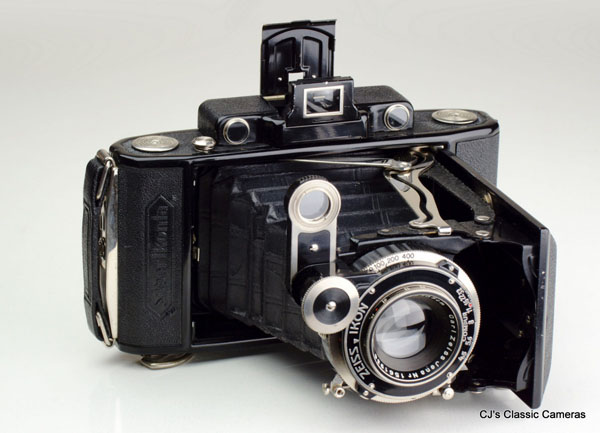
A 1934 Super Ikonta C with uncoated Tessar 105mm f/4.5 in Compur-Rapid shutter.
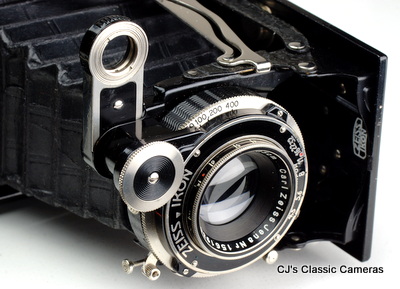 |
Detail showing the lens focusing and rangefinder coupling mechanism. Whilst rotating the silver wheel the lens would change focus and at the same time a rotating wedge in the rangefinder lens would align the coincidence RF patch. Also note the 1/400s fastest shutter speed, typical of very early Compur-Rapid shutters. |
The Super Ikonta was most commonly found with Tessar lens in Compur shutter, although cheaper Triotar lens and Klio shutter were also found. Early production had an Art Deco style shutter face, which was later (from around lens nr. 1,520,000) replaced with a black shutter face. From around lens nr. 1,550,000 the Compur shutters were upgraded to Compur-Rapids with a top speed of 1/400s instead of 1/250s. Although the shutter face still showed 'Compur', the speed ring was engraved with Compur-Rapid. The very latest production before model 531/2 was introduced had sliding covers for the red spy windows at the back as well as reflective frame lines in the viewfinder.
As a side note, the serial# of the Compur-Rapids on the Super Ikontas were in the 4,000,000 range and were as far as I am aware the first Compur-Rapids produced. On all other camera brands with early Compur-Rapid shutters the serial# were in the 5,000,000 range. Interestingly, after the Compur shutter reached the end of the 3,000,000 range, their numbering continued as A,000,000 (so A instead of 4), presumably because the 4,000,000 range had already been used for Compur-Rapids on the (Super) Ikontas.
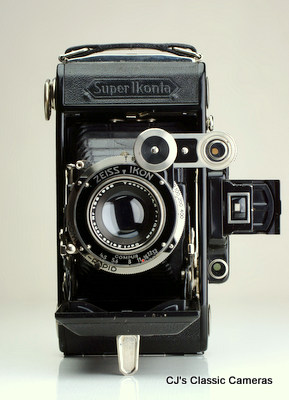 |
Front view of the Super Ikonta showing the alignment of the rangefinder. |
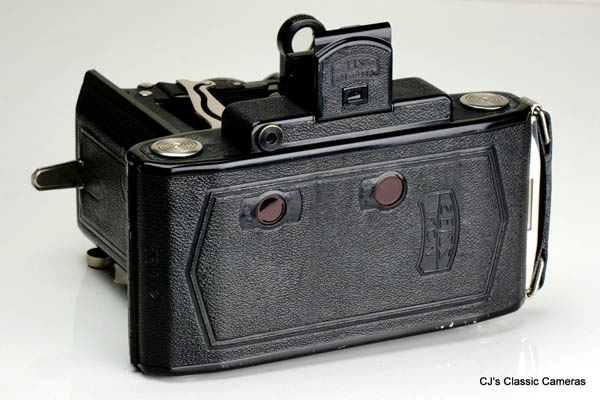
Rear view of a Ikon Super Ikonta 530/2 showing the red spy windows used for 6x9 (left) and 6x4.5 cm (both windows) formats. This early version did not yet have sliding covers for the windows.
Moskva-4
During the decades before and after WWII the Russians made big business out of copying German cameras, often exceeding the success of the originals at least in numbers. The Ikontas were no exception. The Russian versions were made by KMZ, who also made the Zorki range. The first model to be copied was the Ikonta 521/2, initially largely with parts confiscated from the Zeiss factories in Dresden at the end of WWII, and was named Moskva-1 (spelled 'Mockba' in Russian script, as people watching the recent World Cup may have noticed). The Moskva-2 was a nearly identical copy of the Super Ikonta 531/2, the Moskva-4 was very similar but had a flash sync added. Late production had an all metal top cover and was the first Moskva that looked different than its German originals. It was eventually renamed to Moskva-5, the last of the Moskvas.
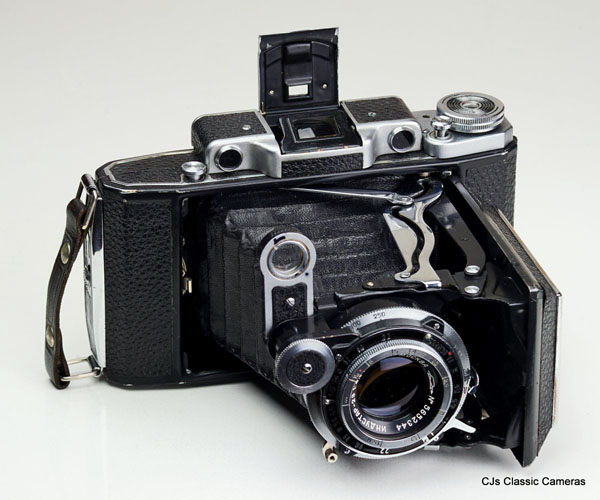
A KMZ Moskva-4 with Industar-23 110mm f/4.5 lens in Moment-23C shutter. The C in the latter is the letter S in Russian and stands for (flash) synchronised. Note in particular the rangefinder mechanism, with the fold-up lever with rotating wedge mounted on the shutter, otherwise unique to the Zeiss Ikon Super Ikonta range.
Super Nettel
The early 1930s were years of great innovation at Zeiss Ikon, giving birth to some of their most iconic cameras, probably spurred on by the success Leitz had with their Leica range and Franke & Heidecke with their Rolleiflex. The Super Nettel was introduced not long after the Contax I and around the same time as the Super Ikonta (see above), and it does have features from both. From the Contax it got the vertical focal plane shutter, whereas it received the rotating wedge rangefinder from the Super Ikonta. The shutters of the early Contax I were notoriously unreliable, so I can only assume that Zeiss put an improved version in the Super Nettel. For what its worth, the shutter of my example still works, in contrast to the one on most Contax I. Like the Contax I, the Super Nettel was finished in black enamel, whereas the Super Nettel II, introduced a few years later, was finished in chrome instead.
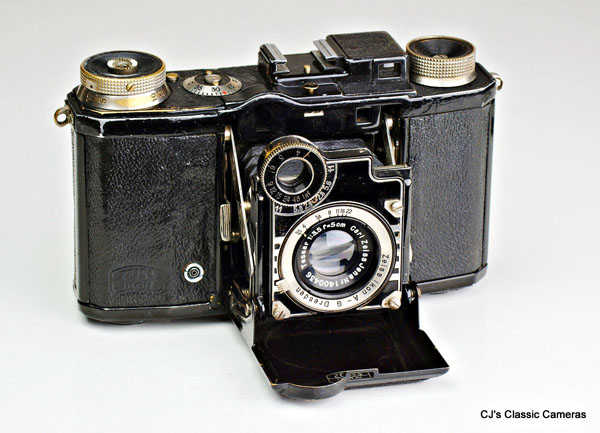
A 1934 Super Nettel with Carl Zeiss Jena Tessar 50mm f/3.5 lens.
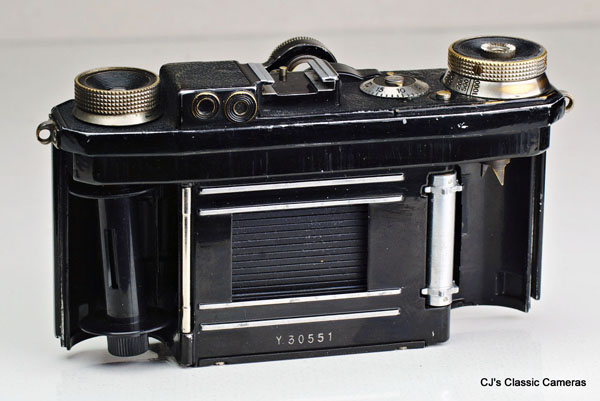
Rear view of the Super Nettel with its back removed, showing the vertical shutter build from metal strips (see also the Contax II below). While taking this photo I clearly failed to notice that the wind spool was sitting at the wrong side.
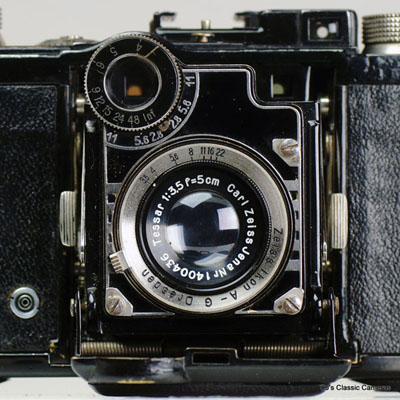
|
Detail of the Super Nettel's Art Deco-style front face showing aperture and focus dials.
|
Nettar 515/2
The Nettar series was a range of folding cameras for 120 rollfilm first introduced in 1934. Most models were available as 6x9 cm, 6x6 cm and 6x4.5 cm versions. The 515/2 was a 6x9 cm version that would shoot eight exposures per film. It was released around 1937. My specimen has a Nettar-Anastigmat 110mm f/4.5 lens in a Klio shutter, the Zeiss version of a Prontor-S. It had a fold-up viewfinder and a wind key at the base of the camera. I particularly like the elegant lines of the chrome struts of the folding mechanism.
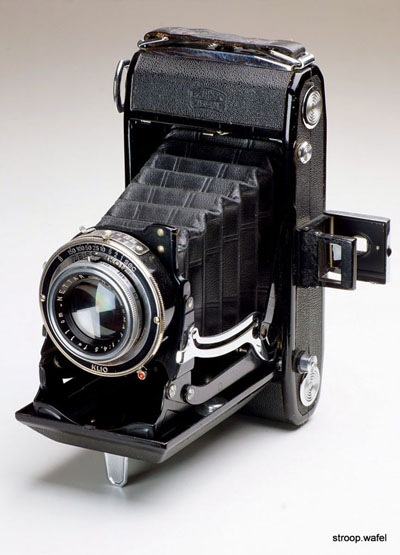 |
A Nettar 515/2 with Novar-Anastigmat 110 mm f/4.5 in Klio shutter. |
Nettar 517/16
The Nettar 517/16 was a bottom-folding 6x6 camera released in 1949. Upgrades with each model number were incremental, the 517 series was the first with fixed viewfinder integrated in a top housing. A rather unexciting and boxy but well-constructed camera that would get the job done. There were two variants of this camera with different top housings, the first being curved, the second more angular.
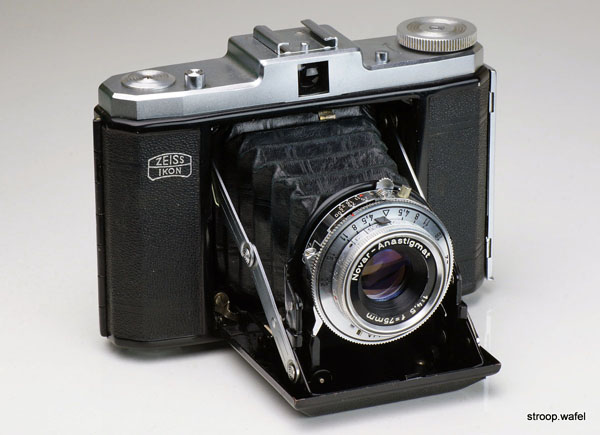
A Nettar 517/16 with Novar-Anastigmat 75mm f/4.5. See here for some sample photos taken with this camera. This is the later version with rectangular viewfinder housing.
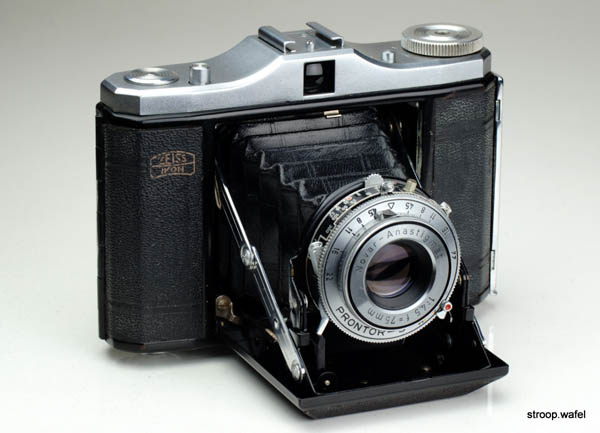
The earlier version of the Nettar with curved viewfinder housing. Like the later version above it sports a Novar-Anastigmat 75mm f/4.5 lens, although on this one the lens ring is silver.
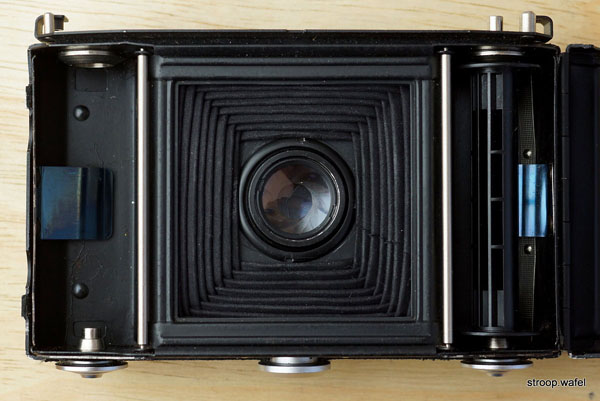
How bellows fold so neatly never fails to amaze me.
Nettax 513/16
Not to be confused with the pre-war 35mm Nettax. The Nettar 513/16 was essentially a Nettar 517/16 (see above) but with lightmeter as well as a double exposure prevention mechanism. The latter worked by displaying a red bar in the viewfinder when the film had not been wound. Very useful for people like me that always forget if they wound the film or not. I prefer to wind on just before an exposure to make sure there is no slack in the film, but if you forget to wind on you waste two exposures. Can't happen on this one!
The lightmeter is a bit of an enigma. It is of the match needle type, so you turn the lightmeter dial until the two needles match up. This is useful when the dial is coupled to shutter or aperture, but on the Nettax it isn't! You still need to transfer the settings to the shutter manually. Having a simple lightmeter that indicated a shutter-aperture combination directly would have seemed a more simple solution. But it looked sophisticated and maybe that's what Zeiss Ikon was going for.
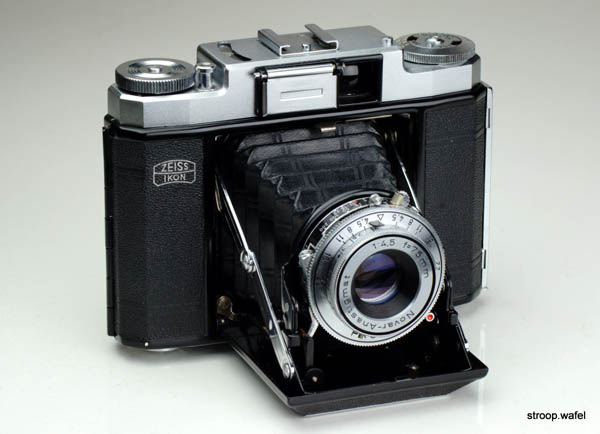
A Nettax 513/16 with, again, a Novar-Anastigmat 75mm f/4.5. I am pleased to say the lightmeter on this example was still working.
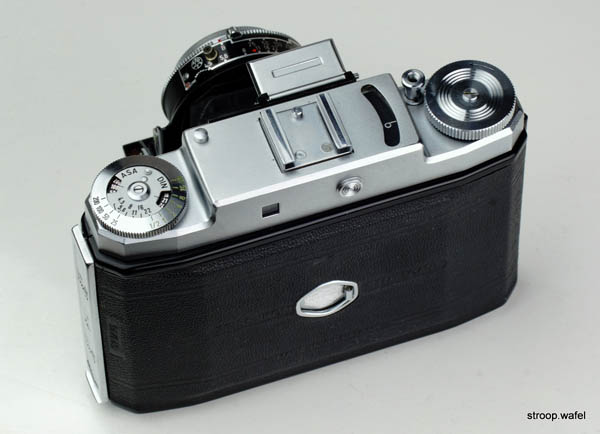
Top view of the Nettax 513/16 showing the uncoupled match needle lightmeter.
Ikonta 521
The Ikonta series was an upgraded range of the Nettar folding cameras, with more chrome parts and often better lenses or shutters. The Ikonta 521 was launched around 1940, although most of the production occurred after WWII. It used the 6x4.5 format for 16 negatives on one 120 roll film. My model has the same lens as the Nettar 517/16 above, but a Prontor-SV shutter. Despite the higher model number, it is an earlier model than the Nettar 517 and had a fold-up viewfinder. It is in fact most similar to the Nettar 516 with top-mounted wind knob and double-exposure prevention mechanism.
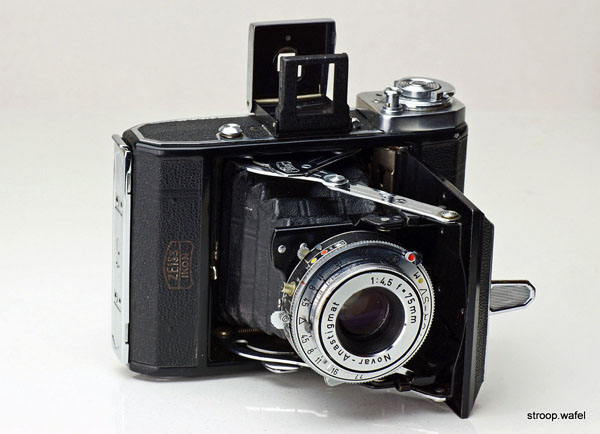
An Ikonta 521. See here for some sample photos.
Mess Ikonta
The Ikonta 524 was also called the Mess Ikonta or Ikonta M, as it had an uncoupled rangefinder. Thus, it wasn't quite a Super Ikonta, which had coupled rangefinder, but it was a step up from the regular Ikontas that only had viewfinders. It was available in two formats: the model number 524/16 referred to the 6x6 format version, whereas 524/2 indicated the 6x9 version. It was available with different lens-shutter combinations, from cheaper Novar-Anastigmats in Prontor-S shutter to Opton-Tessar in Synchro-Compur shutters. The rangefinder wasn't anything special, it was separate from the viewfinder and based on mirrors, not prisms like in the more expensive Zeiss Ikon cameras.
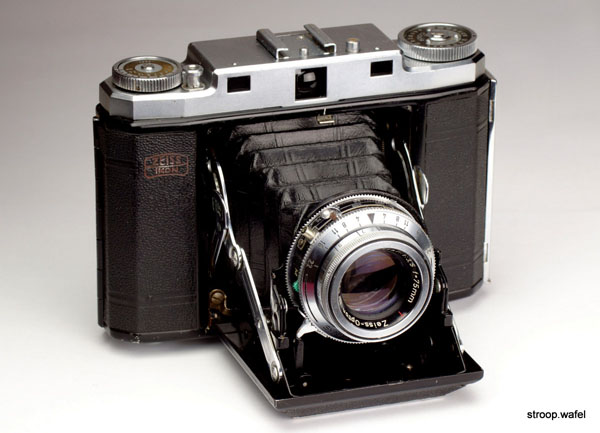
An Ikonta 524/16 with Zeiss-Opton T Tessar 75 mm f/3.5 in Synchro-Compur shutter. I repaired the lens for a client, as it suffered from an apparently fairly common issue: the middle element was misaligned in its brass mount. It was only 0.5 mm out from on side to the other, but that was enough to make photos very soft on one side of the frame. The brass mount needed to be heated up for the glass element to be pushed properly back into place. Buyer beware!
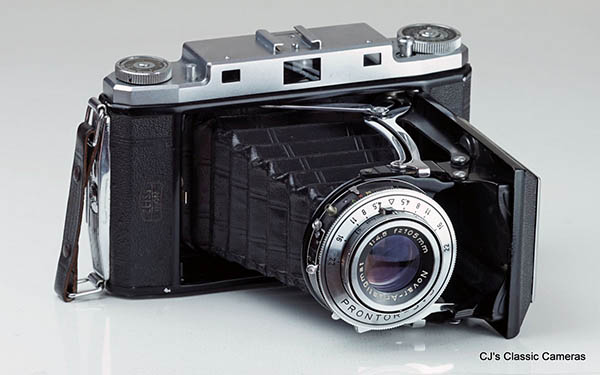
This is the 6x9 version of the Mess Ikonta. Other than the film format, the main difference with its smaller 6x6 sibling shown above is that on the 524/2 the front door opened sideways instead of downwards. Of course, it was also a little wider. The lens on this example is a Novar-Anastigmat 105 mm f/4.5 in Prontor-SVS shutter. A faster f3.5 version was also available, as well as a Tessar version. Although a nice camera, the uncoupled rangefinder is difficult to adjust, as needs to be done by bending the mount of one of the mirrors, but the top plate needs to be put back on to see the result. So lots of trial and error to get it right, hampered further by a small frame (light baffle?) on top of the central viewfinder.
Contina I / Ikonta 35
In addition to the medium-format folding cameras presented above, Zeiss Ikon also produced a small range of 35mm folding cameras. The Ikonta 35, model number 522/24, had started production shortly after WWII and was a viewfinder camera with a front-cell focussing lens. It was a well-build camera with film advance and rewind knobs located at the bottom of the camera. The Ikonta 35 can also be found as its name variant Contina, which was introduced in 1952 and intended for export. There was also a Contina II, which had an uncoupled rangefinder and a separate viewfinder. The top model of the range was the Contessa 35 (see below).
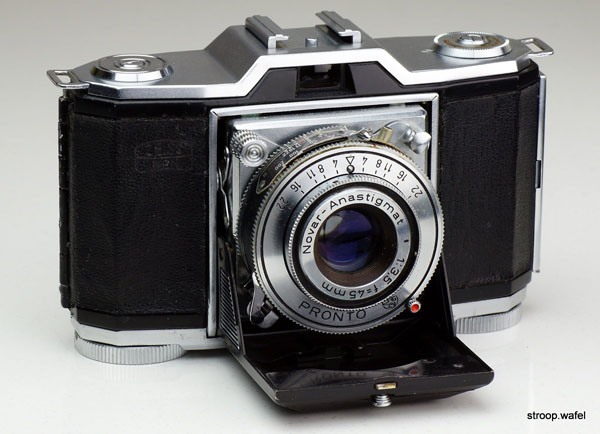
A Zeiss Ikon Contina I with Pronto shutter and Novar-Anastigmat 45mm f/3.5 lens.
Contessa 35
The Contessa 35 may well have been called the Contina III, as it was a better specified version of the Contina II, but Zeiss Ikon chose to market it as the Contessa. It had the same lens baseboard and film advance mechanism as the Ikonta 35/Contina I and Contina II, but was equipped with a coupled rangefinder and an uncoupled lightmeter. The rangefinder used a rotating wedge mechanism, as found in many other Zeiss Ikon cameras such as the Super Ikontas, the Super Nettel, the Nettax and the Tenax II. On the Contessa 35 the wedge was mounted centrally on top of the shutter, giving the camera its characteristic look.
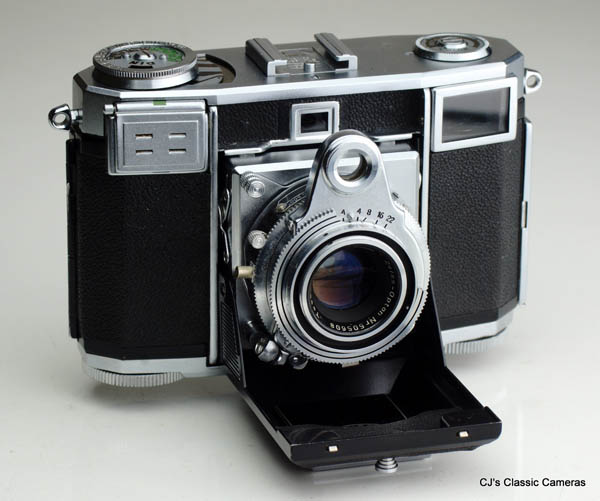
A Zeiss Ikon Contessa 35 with Opton-Tessar 45mm f/2.8 lens in Compur-Rapid shutter. Move your mouse pointer over the image to show the camera with the lensboard closed.
On many Contessas the lightmeter reportedly no longer works and it was the same on this example. However, the lack of lighmeter response was simply due to poor contact between a copper strip with the front of the selenium cell, so I imagine many lightmeters might be brought back to life simply by fixing this contact.
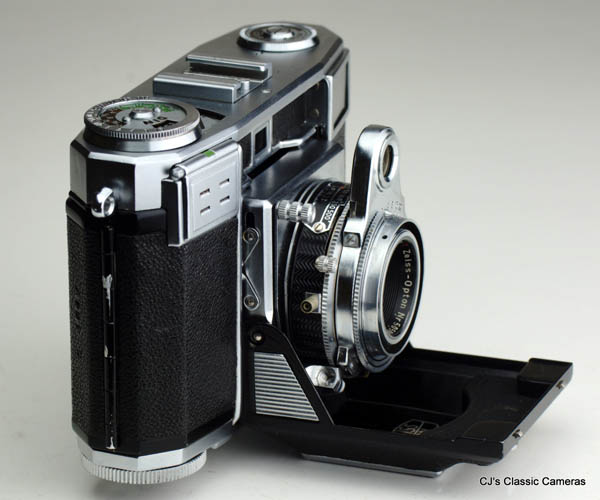
Detail of Zeiss Ikon Contessa 35 showing the distance between the wedge prism mounted on top of the lens and the rangefinder window in the top housing. This example suffered from a degraded semi-transparent mirror, even though this mirror consists of a gold layer in-between two prisms, which meant to avoid such degradation. I had to separate the two prisms, recoat one of the surfaces and glue them back together to restore the rangefinder. The vertical alignment of the rangefinder is adjusted by rotating the two prisms ever so slightly relative to each other when glueing them together.
Zeiss Ikon Box Tengor
Box cameras aren't my favourites, as I find that bar a few exceptions, if you've seen one you've seen them all. However, it's hard to avoid them completely, as every so often they turn up in a job lot of cameras. This Zeiss Ikon Box Tengor was no exception, but that's another story. As one can expect from Zeiss Ikon, it was a well-built camera. The lens was a Goertz Frontar, which gives away some of the history of Zeiss Ikon, which was the result of a merger of the companies Goertz, Ica, Contessa-Nettel and Ernemann, and the Box Tengor was indeed first sold by Goertz. Pre-1928 examples had the viewfinder windows on the same side and wind knob at the bottom, which then changed to windows on opposite sides and wind knob at the top, like my example here. From 1934 the camera got a more elaborate front plate and improved viewfinders, and the camera continued to be developed and modernised until well into the 1950s (still with Goerz branded lens!). Most were 6x9 format, like the one here, although a 6x4.5 version was also available.
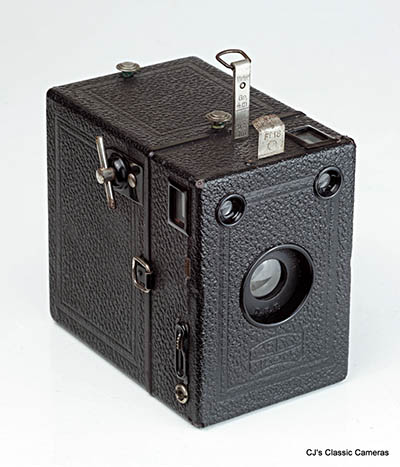 |
An early Zeiss Ikon Box Tengor with Goertz Frontar lens. It had several tabs one could pull to change aperture and focus distance.
|
Zeiss Ikon Kolibri 523/18
The 1930 Zeiss Ikon Kolibri was quite a unique camera, and certainly unusual for its time, when amateur photography was still dominated by box and vest pocket cameras (see my non-Retina Kodak page for examples). This camera belongs to the latter category, but instead of a folding mechanism it has a pull-out lens tube. This was one of the first cameras to do so, and it was likely inspired by collapsible lenses as found on the early Leicas.
It was also a camera of very high specification. It had a fast f/3.5 Tessar (a slower f/4.5 Novar version was available for nearly half the price) lens and a Compur shutter which only recently had been introduced. In addition, the camera had a lever-operated helical focus system, whilst extending and retracting the lens tube was helped by a set of springs, making operation of the camera very smooth. It used 127 rollfilm with a 3x4cm fill frame. This all came in a convenient small package.
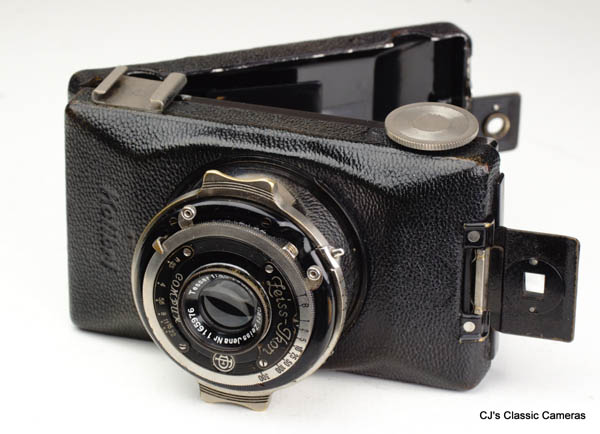
A 1930 Zeiss Ikon Kolibri with Carl Zeiss Jena Tessar 50mm f/3.5 lens in Compur shutter. The accessory shoe is not original, but it is screwed in very neatly into tripod mount. An accessory rangefinder would have been beneficial considering the excellent sharpness of the Tessar lens and the accurate focus one could achieve with the helical focus lever.
One remarkable feature of the Kolibri is how large a diameter of the lens tube is. In principle, this would allow for much faster lenses than the f/3.5 Tessar, and indeed f/2 Xenon and f/2 Biotar version have been seen. I suspect these were probably special (after-market?) orders, as I have never seen these so-called 'Night Kolibri' models in any Zeiss Ikon brochures. Prices for these are astronomical these days, as they would have been at the time.
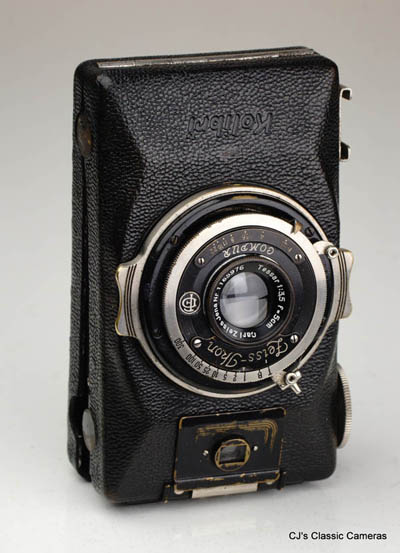
|
The Zeiss Ikon Kolibri came with a support stand that needed to be screwed into the bottom of the lens tube, which allowed the camera to stand in vertical position (for long exposures). Although the lens tube could be retracted with the stand in place, this was awkward and therefore there was a dedicated slot for storing the stand in the camera case. This cumbersome design is the reason that nowadays the stand is often missing (like here), especially when there's no case with the camera.
|
Ikoflex 850/16
The Zeiss Ikon Ikoflex was Zeiss' answer to the success of the Rolleiflex, which had been introduced a few years earlier and had rapidly gained a great reputation, with sales to match. Zeiss would not be Zeiss if it did not try to improve on the competition: this was the whole idea behind the Contax (competing with Leica). So Zeiss designed an advanced TLR with lever wind mechanism and automatic frame counter, and a lever-operated focus mechanism. It was nicknamed the 'coffee can' due to its shape, which was apparently reminiscent of German WWI coffee cans. It was the first in a long line of Ikoflex that lasted until the late 1950s, and although subsequent models were more traditional and did not reach the fame of the Rolleiflex, they were close in terms of quality, and are still a great investment when looking for a reliable medium-format TLR.
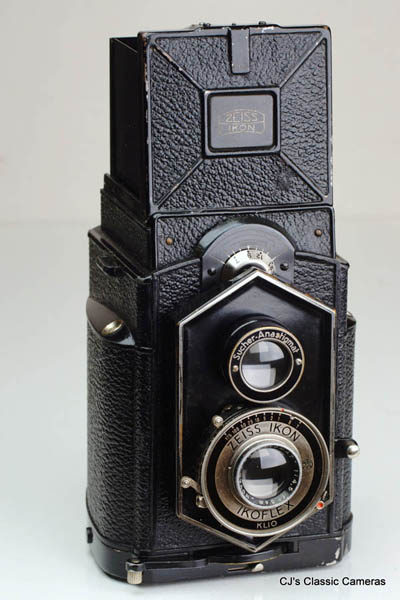
|
Zeiss Ikon Ikoflex 'coffee can' with its Art Deco faceplate and Novar Anastigmat 80mm f/4.5 lens in Klio shutter. This is the second version of this first model, the original version had a different cap.
|
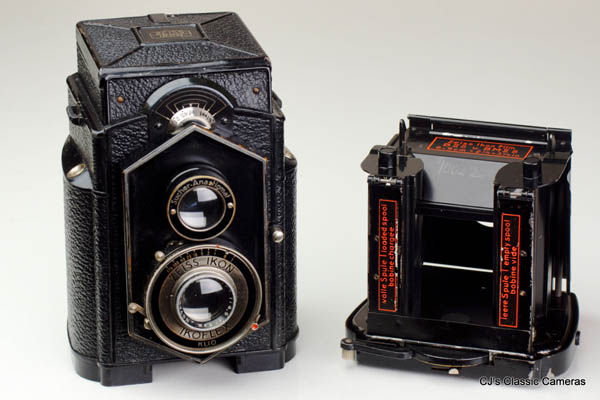
Zeiss Ikon Ikoflex with its film holder removed. Note that the film travel is horizontal, which is rather unusual for TLR cameras, although it was the same for the Voigtlander Superb (which mechanics, however, worked very differently). At the bottom of the film holder one can see the film transport lever. Film transport was automatic; no red window was needed (other than to load film and forward to the first frame) and the camera had a frame counter instead. In fact, it had two, one for 120 film and one for 620 film, as it could handle both formats.
Ikoflex II (850/16)
The Zeiss Ikon Ikoflex II replaced the 'coffee can' above and represented a move to a more regular TLR design with hinged back and vertical film travel. It did, however, feature a quite unique focussing lever on the side of the camera, where most other TLRs had a rotating knob. Like the 'coffee can', it had a frame counter and automatic film winding. It was available with a range of shutters and lenses, the top model having a Compur-Rapid shutter and a Tessar lens. It can be found with either black enamel or chrome metal details.
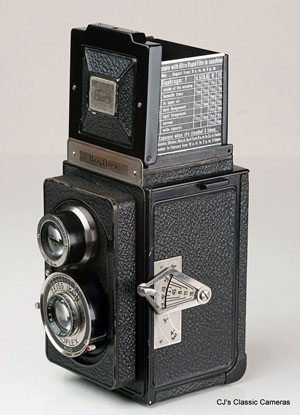 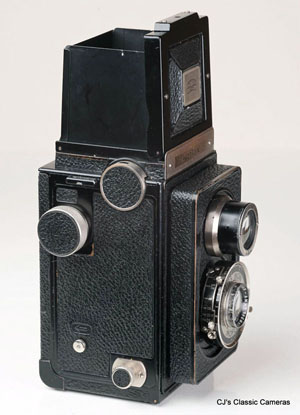
Zeiss Ikon Ikoflex II with Novar Anastigmat 80mm f/4.5 taking lens in Klio shutter. My favourite feature of this camera is the unusual kite-shaped wind lever with depth of field scale.
Contax I
The Contax I was introduced in 1932 and was Zeiss Ikon's first 35mm camera. It was essentially designed in response to introduction of the Leica rangefinder a few years prior, which had taken the market by storm. It's important to realise that Leitz had no real history in making cameras, which made it all the more remarkable that their first camera threatened to completely upset the status quo amongst camera makers, with Zeiss Ikon considering itself to be at the very top. So an answer to the Leica had to be made, quickly, and it had to be even better. That was the background to the first Contax, and the need to be different, partially trying to be better, partially to get around Leica patents, resulted in an impressive but overly complex camera. Moreover, the need for speed meant it had technical flaws that still needed to be ironed out, which was rather unlike Zeiss Ikon. Thus, the early Contax gained a fairly poor repuation for reliablity, and one could say that ZI shot themselves in the foot. Later iterations (Contax II, IIa, III and IIIa) fared better (see below) but it was a steep learning curve.
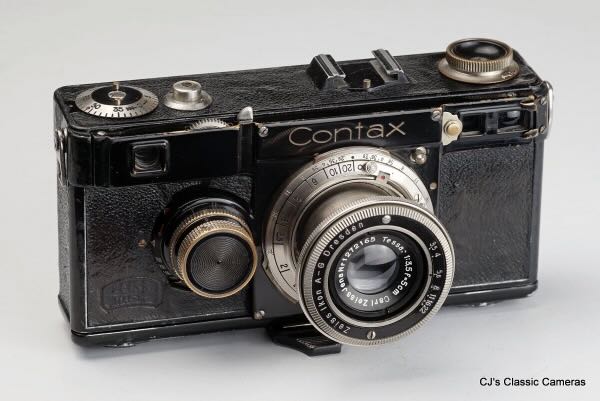
A Contax I with collapsible Carl Zeiss Tessar 50mm f/3.5 lens. I find it a rather utilitarian looking camera with its rectangular lines and black paint. Note the rather prominent knob next to the lens, which is the wind knob and shutter speed selector. On later Contax models it was more conveniently found located on the top plate.
That said, the Contax was still a marvel of technique and an impressive camera to hold. Its operation was complex and far from intuitive, you better pick up a manual before playing with it. The big knob at the front was there to wind the shutter as well as to adjust the shutter speeds, and for the latter it had two separate dials, one to set one of four 'groups', each of which contained a range of shutter speed options, and one to set the actual shutter speed. The reason for this was the operation of the focal plane shutter, which was rather unusual, especially for slow speeds. Most focal plane shutters control slow speeds (speeds where the second curtain is released after the first curtain has finished travelling completely, so generally slower than ca. 1/25-1/30s) with a delay timer, which delays the closing of the already released second curtain for a certain length of time. In contrast, the Contax shutter works by increasing the gap between the first and second curtain, like indeed most focal shutters do for fast speeds. As this gap would become too big at the normal rate of curtain travel for speeds up to 1 second, it needed to be slowed down by making it push against a speed cam, until the last part where it travelled across the film frame. Confusingly, or perhaps conveniently, 1/100 was available in two of the four speed groups, meaning there were two different ways the camera could achieve this speed. Good luck getting those two to run at the exact same speed!
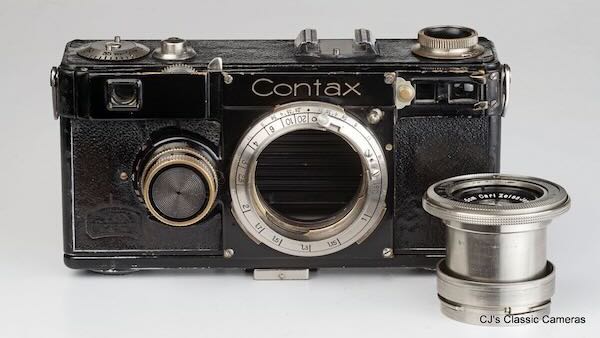
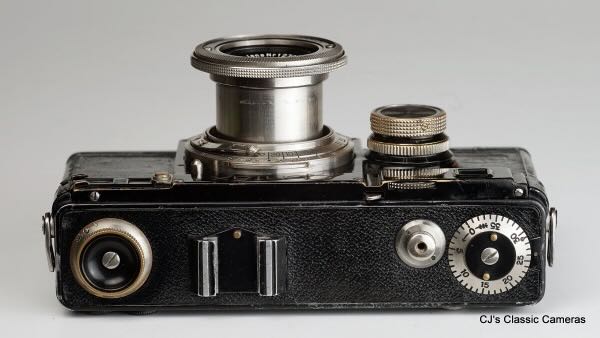
(left) A Contax I with its lens unmounted. (right) Top view of a Contax I, showing the sizeable wind knob at the front more clearly.
The Contax shutter had two other very obvious differences compared to the Leica shutter: it travelled vertically instead of horizontally, and it was made of narrow metal slats instead of cloth. This became the standard for Zeiss Ikon cameras, and the same features can be found on e.g. the Contaflex TLR and the Super Nettel, as well of course on later Contax models, as well as the Russian copy, the Kiev. Another difference was that both curtains were operated by a single roller with a complex spring mechanism, so it was difficult to adjust the speeds of the curtains individually, although that isn't necessarily a bad thing. To finish off, the second curtain would travel along the shutter ribbons that held the first curtain and therefore its speed was partially determined by friction with the ribbons, which would be moving themselves using fast speeds, but not whilst using slow speeds, adding to the difficulty of fine-tuning shutter speeds.
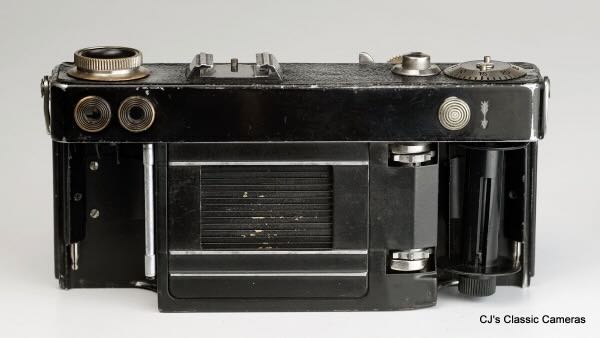
Rear view of a Contax I with the back removed, showing its metal focal plane shutter. Note the two eye pieces, one for framing, one for the magnified rangefinder.
Another important feature of the Contax was its rangefinder. It had a very wide base compared to Leicas, thus improving focussing precision, which is important for high-speed lenses with shallow depth of field such as the 50mm f/1.5 and 85mm f/2 Sonnar lenses that were available for the Contax. In addition, it provided a 1:1 magnification and therefore there was a separate viewfinder for framing your shot, which gave a wider field of view.
The focussing mechanism of the Contax was also unusual, as it rotated and extended the lens mount, not the lens, so the standard lenses had no focussing mechanism (making them difficult to adapt for modern DLSR cameras). The lenses had a bayonet mechanism, which made them quicker to change than the Leica screw thread, although only standard lenses would mount directly onto the focussing mount. Wide angle and telelenses would mount onto a separate bayonet and these lenses therefore had their own focus mechanism, but the rear of the lenses would engage with the focus mount, thus enabling coupling with the rangefinder.
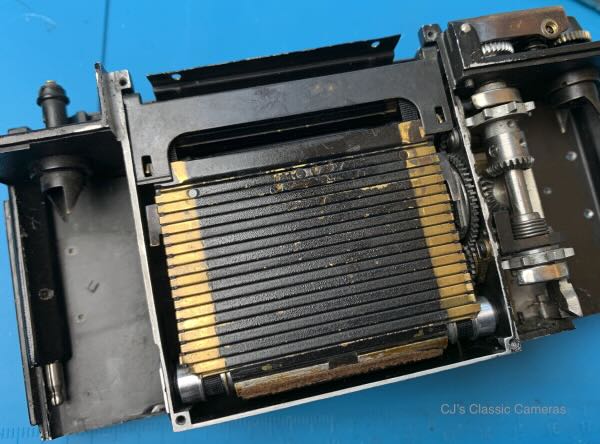
Contax shutter after partially dismantling the camera. The horizontal flap near the top holds the first curtain (after winding the shutter), which is released by lifting the flap slightly. The second curtain isn't visible as it's inside the camera, with a gap between the curtains proportional to the selected shutter speed. A very different design than Leica-style focal plane shutters.
One litte known feature of the Contax that neatly shows the amount of thought Zeiss Ikon put into their products were the dedicated reloadable film cassettes that engaged with the two locks at the bottom of the removable camera back. Remember that at the time the Contax was introduced, the 35mm film roll as we know it wasn't yet available, so photographers needed to load their own film cassettes. The Contax was supplied with two cassettes, and the film chamber was designed so that the cassettes would only fit in a specific orientation. After mounting the camera back, winding the lock keys would rotate and open the hull of the cassettes so film could pass through easily. Whilst unlocking the back the canisters would close again, thus avoiding accidental exposure of the film. Once preloaded 35mm film cassettes were introduced by Kodak, alongside their Retina cameras, in the mid 1930s, this system became more or less obsolete, but it's interesting that the double-locking camera back remained a feature of later Contax (and other Zeiss Ikon) models, and in fact even of Kievs produced until the 1980s.
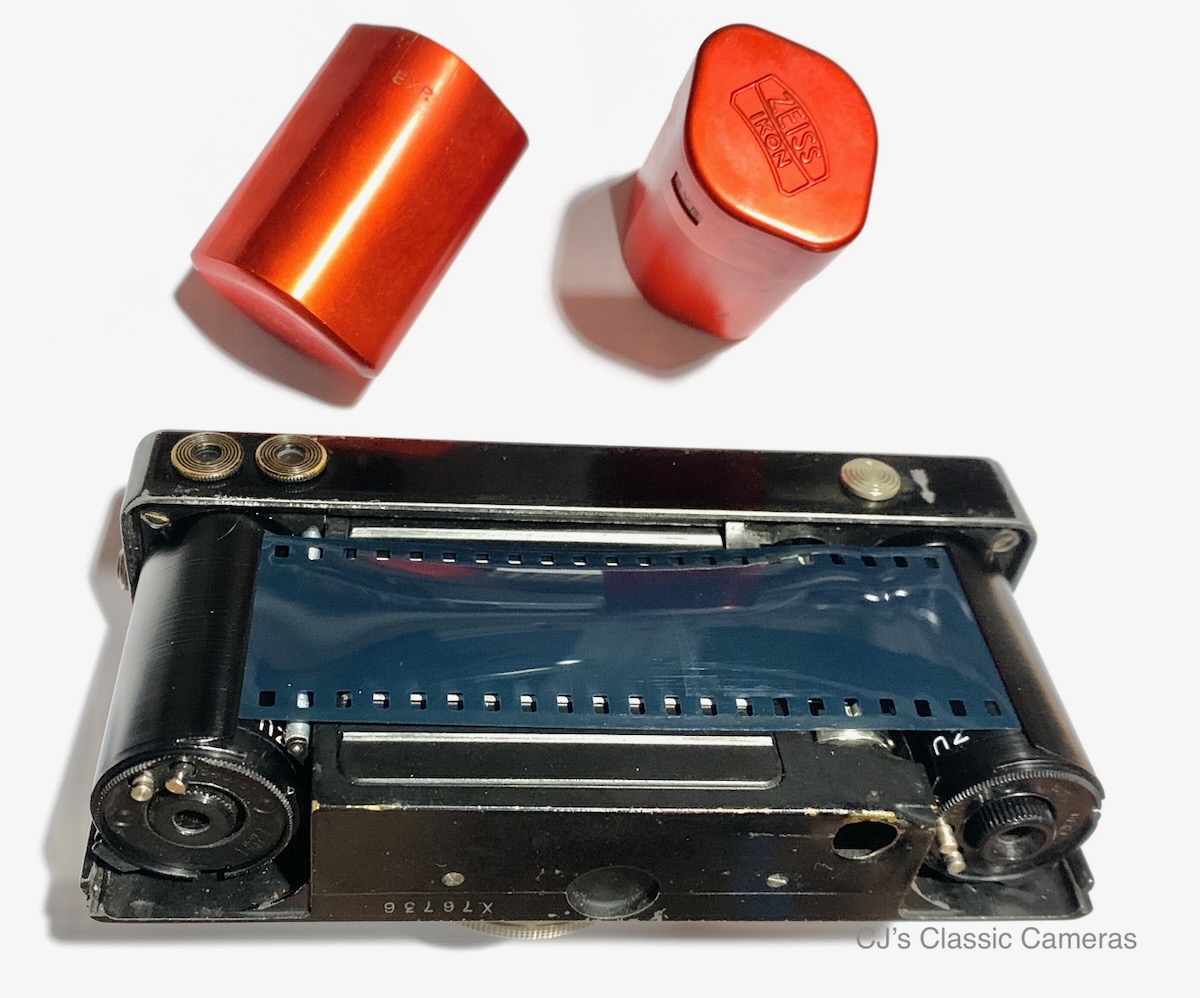
Contax I loaded with two film cassettes. It's a little difficult to show, as the magic happens behind closed doors (with the camera back mounted), but basically the metal pins of the cassetes engage with slots in the two camera back locking keys, which upon closing rotate the hulls of the cassettes and thus expose open slots for the film to pass through. The slots are currently closed (note the word 'zu', meaning 'closed' in German). Also shown are the cannisters for the cassettes, which are rather impressive themselves. The top fits on in two ways, one of which shows the letter 'EXP' through a little window, meaning the film inside is exposed. It's all in the details!
Contaflex (TLR)
The Contaflex TLR was introduced in 1936 and it was a rather unusual camera, as it was a 35mm TLR (twin lens reflex). Not that the film format of the Contaflex is immediately obvious, the camera is about the same size as its 120 film format sibblings. Ironically, it's probably also heavier, as it weighs about 1.5 kg or over three pounds. One reason for its weight is that this was the first camera with a lightmeter, which contained a rather heavy magnet. The lenses also added considerable weight, particularly the f/1.5 Sonnar model. Finally, the camera contain a lot of chromed brass and had a rather heavy shutter, very similar to the Contax shutter. Essentially, as the name already indicated, the Contaflex was a TLR version of the Contax rangefinder, although the lenses were unfortunately not interchangeable (with the Contax). But they were interchangeable in their own right, several 85mm as well as 135mm lenses were available - another rather unique feature not often found on other TLRs. The Contaflex also had a double-locking camera back designed with the dedicated reloable Zeiss film cassettes in mind (see Contax I for more details).
Small format TLRs are a rather rare breed, other examples include the Agfa Flexilette and Optima Reflex, and the Samocaflex. I am not totally sure why, perhaps the main reason is that because the camera is smaller, the waistlevel viewfinder is smaller, which reduces one of the benefits of having a TLR camera.
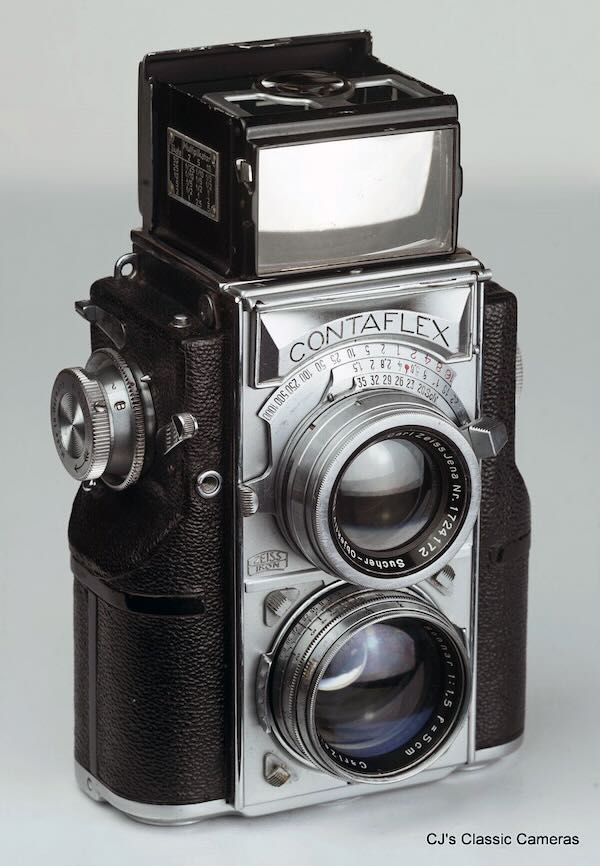
A Contaflex TLR in all its magnificence. This example is equipped with a Carl Zeiss Sonnar 50mm f/1.5 taking lens, a speed which I don't think has ever been rivalled by other TLRs. The viewing lens was a 80mm f/2.8 lens, thus providing an enlarged view to help focussing and somewhat negating the slower aperture compared to the taking lens. The camera also had direct viewfinder, which was useful for accurate framing. It showed frame lines for 85 and 135 mm lenses which were also avalaible for use with the Contaflex. Slower but cheaper taking lenses were also available, an f/2 Sonnar (slower being relative here!) and a f/3.5 Tessar.
The Contaflex also rivalled the Contax I in complexity of operation. In addition to the wind knob it has a number of levers and buttons of which the operation isn't immediately obvious, so it's not a camera you'd want to tackle without a manual, especially considering it's rather fickle reputation. As changing shutter speeds often results in a shutter curtain moving, it feels quite laboured compared to Leica-style shutter, which doesn't help confidence in its operation if you're not used to it.
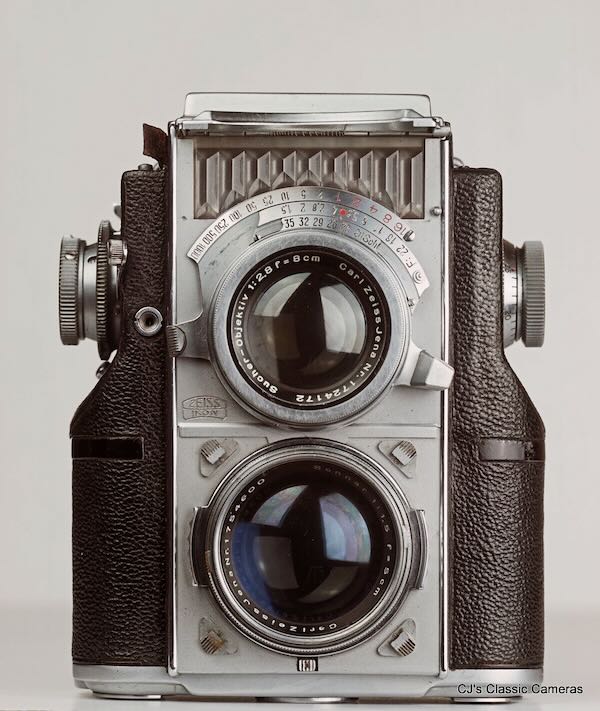
| |
Front view of the Contaflex with the lightmeter cover flipped open. Say cheese!
|
The inclusion of a lightmeter made the Contaflex far ahead of its time. It was new technology based on light-sensitive material that emitted an electric current when hit by sunlight, essentially a solar cell, and needed a magnetic field so that the lightmeter needle would move in response to a changing current. Magnets were weak compared to modern versions and so was the current delivered by the solar cell, which explains the rather oversized chunk of metal (the magnet) built into the camera. But like most new technology, it needs to start somewhere and development depends on early adopters. It wasn't another 15 years later before lightmeters became more commonplace and by that time they had become considerably lighter.
All in all, the Contaflex was a rather incredible camera. A TLR with coupled lightmeter, interchangeable lenses, sporting some of the fastest lenses available, and shutter speeds up to 1/1000? Well, here you have it, and it's only the 1930s. This camera wasn't really rivalled until decades later. I doubt it's weight to film format ratio was ever surpassed!
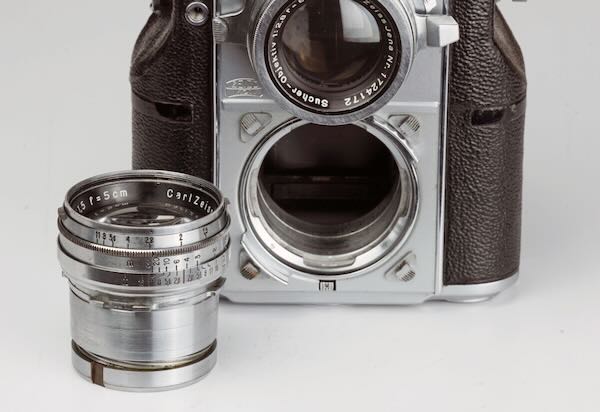
A Contaflex TLR with its taking lens dismounted. Like on the Contax, telelenses used a separate mount, but their focus mechanism was connected to the focusing helicoid and thus the viewing lens. This allowed focussing using the waist-level viewfinder just like the standard lens.
Contax III
The Contax range of cameras was Zeiss Ikon's top of the line and was developed in response to the Leica 35mm cameras, which had reached great reputation and popularity soon after their introduction (see Contax I above). The Contax I was first produced in 1932, but was plagued by shutter problems. An improved version, the Contax II, began production in 1936. A version with lightmeter on top, the Contax III, was introduced the same year. After WWII both models were updated to the Contax IIa and IIIa, respectively (see Contax IIa below)
It had an interchangeable bayonet mount and a vertically travelling focal plane shutter with metal curtains.
An unusual feature of the Contax cameras was the focus wheel in front of the wind knob. It rotated the lens helicoid, thus focusing the lens, and actuated the rangefinder. This rangefinder was very accurate due to its extremely wide base (ca. 90 mm!), in fact it took me a little getting used to as the two images are distorted for anything which isn't exactly aligned horizontally or vertically relative to the camera.
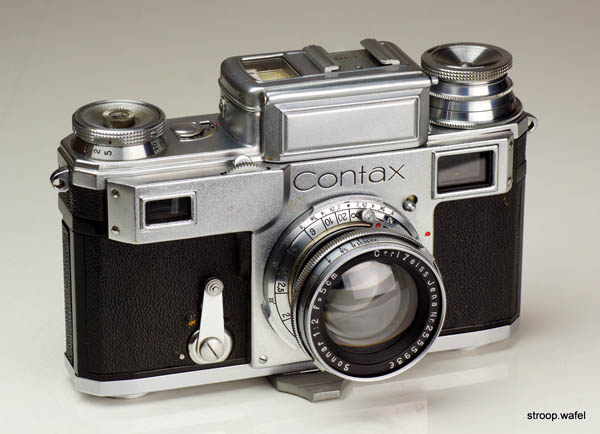
A Contax III with collapsible Carl Zeiss Sonnar 50mm f/2 lens. The body serial number indicates it was made in the first half of 1939, whereas the lens was made in spring 1939, so quite likely it is the original lens that came with the camera.
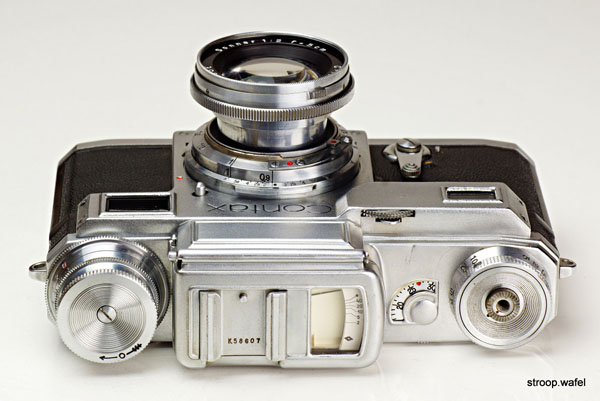
Top view of Contax III with the collapsible Sonnar 50mm f/2 lens extended. The most noticeable feature was the large uncoupled lightmeter. One could determine the correct exposure by turning the various dials of the knob on the left (exposure, film speed and aperture) until the lightmeter needle would point to the diamond-shaped mark.
Most camera collectors will have come across fake Leicas at some point, as the similarity of early FEDs and Zorkis made it easy to change the markings on them and then fool unexperienced buyers into thinking they got a good deal on a real Leica. Less well known is that the same happened to Contax cameras. Again, as Kievs were based on the Contax, they were easy to 'convert'. In fact, the first post-war Contax came from the Kiev factory and were made from original parts taken from the Zeiss factories in East-Germany. In any case, at some point late last century black Contax II and III started to appear. This was unusual as only the Contax I was produced in black enamel. Of course the suspicion was that these were in fact Kievs, and it didn't take long to prove this, as original engravings could be seen on the inside of the body parts. So if you see a black Contax II or III for a good price, be warned!
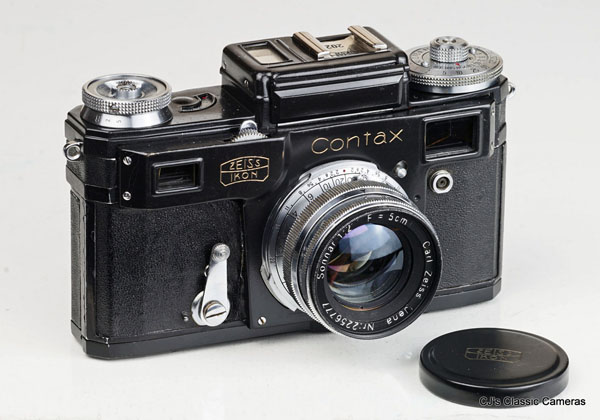
A black Contax III matching Carl Zeiss Sonnar 50mm f/2 lens. Or not? I normally don't buy fakes, but I do like the look of a black Contax III, and it is unfortunate Zeiss never made them. That this is a Kiev isn't hard to spot, in fact it is not even one of the early models, it is a Kiev 4 as evidence by the square edges of the lightmeter, the style of the rewind knob and the presence of a flash socket.
Kiev II
The Kiev was a Russian copy of the Zeiss Ikon Contax. At the end of WWII, the Russians got hold of Zeiss machining equipment and Contax parts from the Jena factory and started to build their own copies of the Contax II. Mass production of the first model, the Kiev II, started around 1950. The Kiev II and III were essentially identical to their Contax counterparts, which was also reflected in their numbering - there never was a Kiev I. Later Kiev IIa and IIIa models had flash sync connectors. The Kiev 4 (with lightmeter) and Kiev 4a (without) had some slight modifications to the wind knobs and can be seen further below.
The Kievs were made for a much longer time than their German counterpart (until ca. 1980 vs. ca. 1960) and most likely in much larger numbers. They changed very little so that even the late 70s cameras were still very much like the pre-war Contax II and II. The lens designs were copied as well, for example, the Sonnar 50mm f/2 and f/1.5 became the Jupiter-8 and Jupiter-3, respectively.
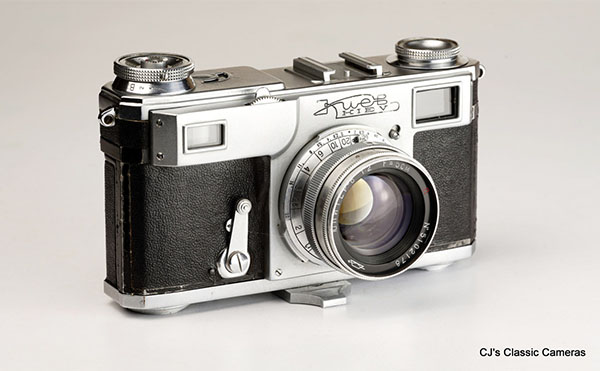
A Kiev II with Jupiter-8M 50mm f/2 lens. The Kiev II was remarkably similar to the Contax version. Perhaps it shouldn't be surprising, they were copies after all, but most parts were so similar they could be used interchangeably.
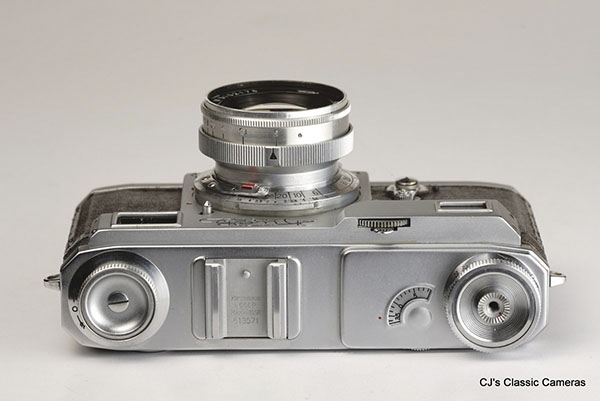
Top view of the Kiev II. The first two digits of the serial number (engraved in the accessory shoe) indicate the year of manufacture: 1951.
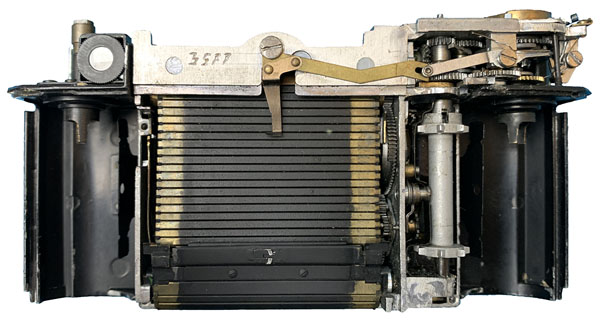
Photo of the Kiev II shutter mechanism, unsurprisingly very similar to that of the Contax II.
Contax IIa
The Contax IIa was introduced after WWII by the West-German branch of Zeiss Ikon. The company had basically become split in two after the division of Germany into East and West, and the two branches started to compete for the rights of the names and patents they both claimed to own. The West-German part won most of those in the end, but not without a long fight. The Contax was one of Zeiss Ikon's most lucrative models so it is no surprise that it became part of the animosities. The East German branch in Dresden had nearly been fully destroyed at the end of WWII and it took a long time to rebuild. In addition, any remaining equipment had been raided by the Russians and shipped to the Ukraine, where Contax II and III copies were produced (the Kiev, see below). Most likely, they also exported fake Contax cameras to the West, after all, they had the parts and the equipment. The East-German Dresden plant also started making Contax again, albeit in small numbers. In the meantime, probably to kill off this competition, the West German Zeiss Ikon started to work on an upgrade of the Contax. This became the Contax IIa and IIIa, which were introduced in 1952.
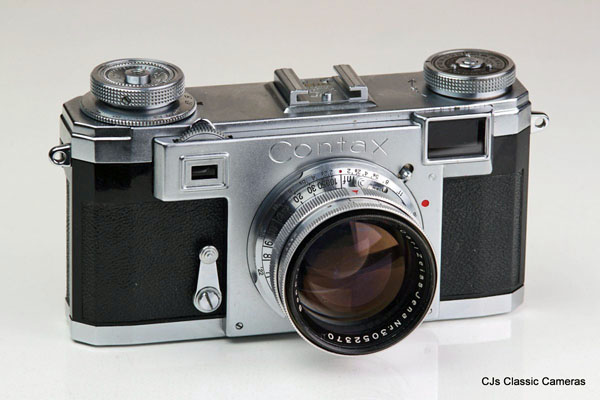
A Contax IIa with coated Carl Zeiss Jena Sonnar T 50mm f/1.5 lens. The latter is from the East German branch of Zeiss Ikon, whereas the camera body was of course made in West Germany. As the East German plant lacked resources after WWII, they build lenses with aluminium bodies, which were considerably lighter than the chrome plated brass lenses they made before WWII and in the West German branch. As this is a very early example of the Contax IIa (serial# indicates it was only the 136th body leaving the factory), the presence of a Jena lens is not surprising, as the West German plant started making cameras before they started making lenses. The lenses from the West German branch were initially called Zeiss-Opton, later Carl Zeiss (without Jena).
The new models were considerably lighter and somewhat smaller than their predecessors and had redesigned shutters, with the aim of making them more reliable, and had a higher top-speed of 1/1250s. The rangefinder design was simplified and flash synchronisation was added. This was the last Contax model though, as like most other manufacturers, Zeiss Ikon started to focus their efforts on the SLR market instead (see Contarex below).
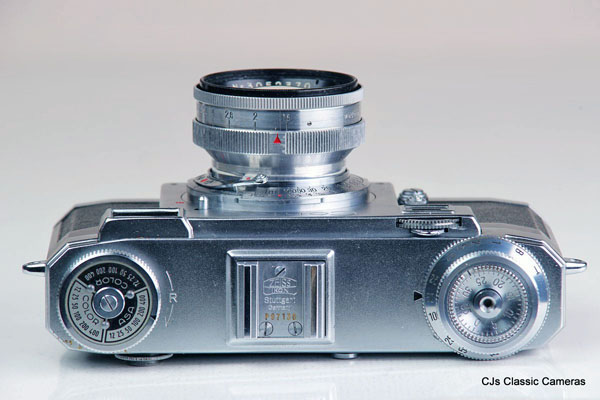
Top view of the Contax IIa, which was a lot less cluttered than its predecessors.
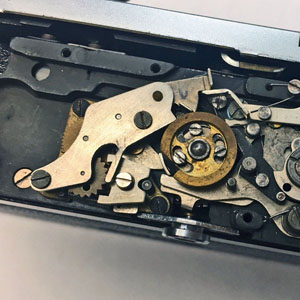
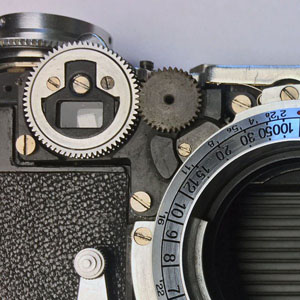
(left) If you get a Contax IIa, there's a good chance the slow speeds stick. The reason is (a little to my surprise) that the slow speed mechanism is essentially the same as found on Prontor shutters, it's just been made to fit inside the top housing (it's the part to the left of the brass wheel, which is the top of one of the curtain rollers). They are very sensitive to dirt and grease, but luckily, are also very easy to clean and to get working again. (right) Another part that may give trouble is the focus mechanism. Too my surprise, it turned out it wasn't the focus helicoid itself that was stiff, but these cogs that connect to the rangefinder (there is a few more in the inside). Again, they are easy to clean - problem solved.
Kiev 4
As explained above when introducing the Kiev II, the Kiev 4 was a Russian copy of the Zeiss Ikon Contax III. It wasn't exactly the same, as it had flash syncs as well as some slight modifications to the wind knobs.
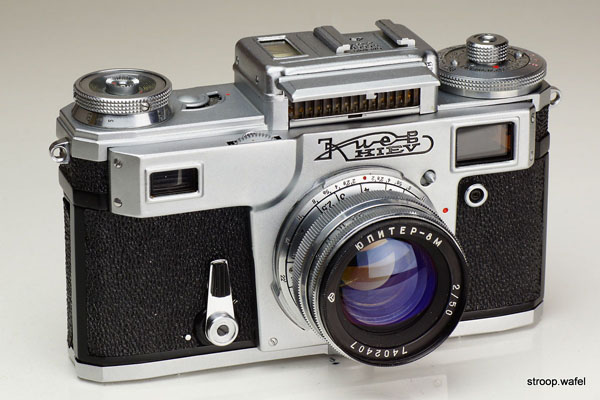
A late version of Kiev 4 (from 1975) with Jupiter-8M 50mm f/2 lens.
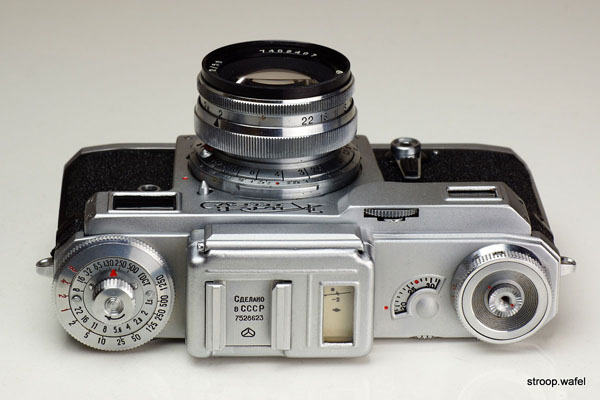
Top view of a Kiev 4 showing the coupled lightmeter and the large shutter speed wheel beneath the tiny rewind knob.
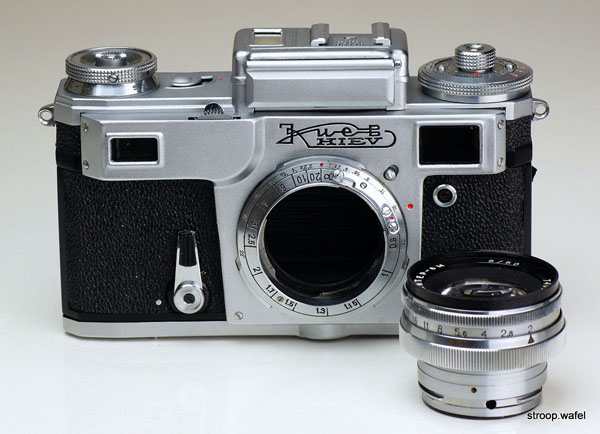
Kiev 4 with lens dismounted. The helicoid for this lens is in the Kiev body. All other compatible lenses had their own focusing mechanism and would attach to the outer bayonet, thus covering the whole lens mount.
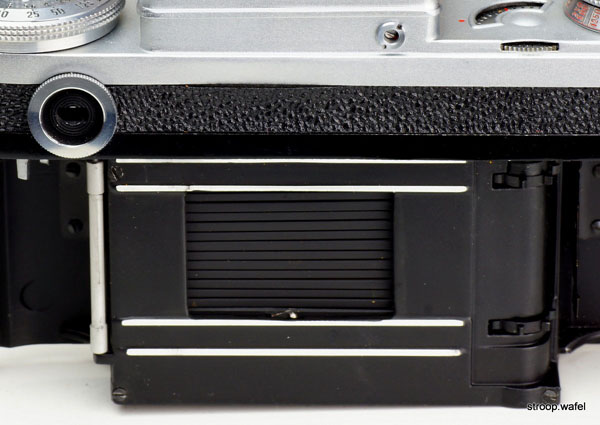
The unusual Kiev (and Contax) shutters consisted of metal rods held together by silk ribbons, they travelled vertically.
Kiev 4AM
The Kiev 4AM was the last version of the Kiev copies of the Zeiss-Ikon Contax II, i.e., the Contax without lightmeter. It was produced as late as 1987, decades after the last of the original Contax came of the production line. The design of the Kiev 4AM was still very similar to its predecessors, the Kiev II, IIa, 4 and 4A, respectively, the main difference between all these being the wind/speed knobs. On the Kiev 4AM these were for the first time partially made of black plastic instead of all metal.
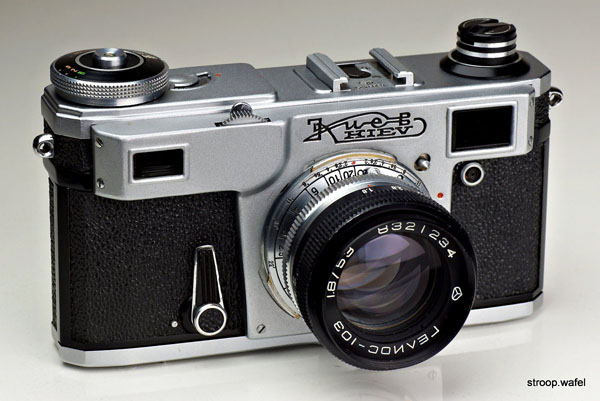
A Kiev 4AM with Helios-103 53mm f/1.8 lens. This six-element lens was introduced in 1978. Whereas the previous standard lens for the Kiev, the Jupiter-8, was a copy of the Zeiss Sonnar with its asymmetric design, the Helios had a double Gauss design like the Zeiss Biotar. By this time no longer a particular fast lens or modern design, but the Helios-103 did have a good reputation.
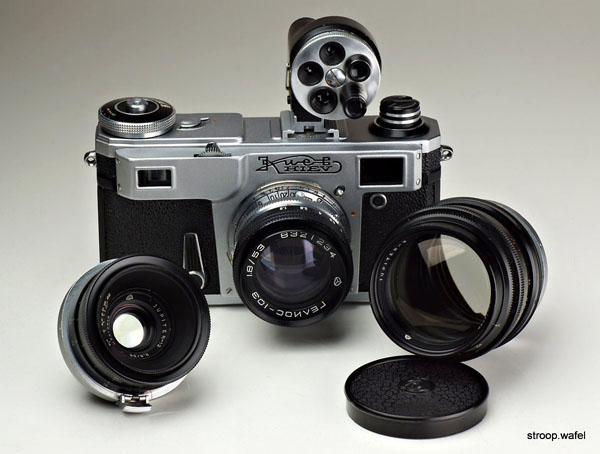
A Kiev 4AM outfit with three lenses, the aforementioned Helios-103, a Jupiter-12 35mm f/2.8 wide angle lens and a Jupiter-9 85mm f/2 fast portrait lens. Mounted on top of the Kiev body is a multi-viewfinder with rotating turret for 28mm, 35mm, 50mm, 85mm and 135mm focal lengths with parallax correction.
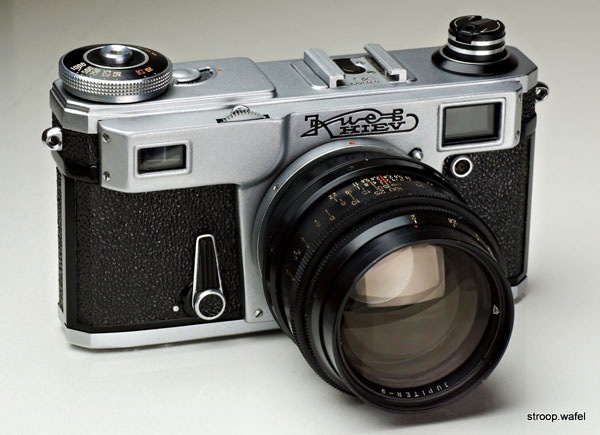
A Kiev 4AM with Jupiter-9 85mm f/2 lens. The lens mount of the Contax/Kiev had a particular feature: standard lenses as they were mounted on the focussing helicoid that was part of the lens mount, whereas other lenses were mounted on a bayonet surrounding it. Therefore, standard lenses had no focus system whereas other lenses did. Through a rather ingenious system, even for non-standard lenses rangefinder coupling was still maintained, as well as focussing with the focus wheel on top of the camera.
The Jupiter-9 85mm f/2 lens was a copy of the Zeiss Sonnar and had seven elements in three groups. It was produced in Contax, Leica screw and m42 mounts, and still has a great reputation for being very sharp except wide open and having great bokeh characteristics.
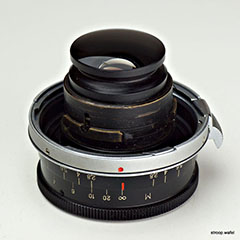
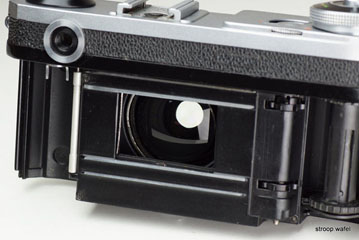
The Jupiter-12 was a copy of the pre-war Zeiss Biogon, a six-element lens with a very characteristic, far protruding rear element. On the Jupiter version the rear group did not even have a retaining ring, the whole lens base was simply a large chunk of glass! When mounted onto the camera, this rear element would sit very close to the film frame, as I have tried to show on the picture on the right with the shutter open.
Contax-S
The Contax-S was a revolutionary camera, as it was the first camera to be designed with a pentaprism viewfinder (although it was beaten to the market by the Rectaflex). More details can be found on my SLR page.
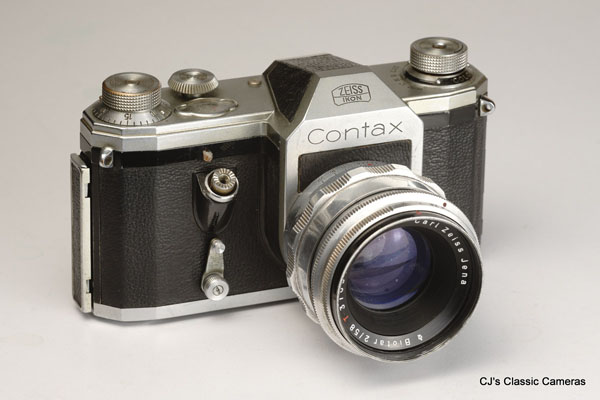
A Contax-S with Biotar 58mm f/2 lens mounted.
Tenax II
The 1937 Tenax II was a camera of similar quality and style as the Contax and Super Nettel, but was quite different internally, as it was a square frame 24x24 camera with leaf shutter. It did feature a coupled rangefinder, using the same rotating wedge system as the Super Nettel. The Tenax II had an interchangeable lens mount, each of which had their own rotating wedge. Zeiss claimed this was one of the first leaf cameras with interchangeable lens mount. The camera also featured an ingeneous lever system that would cock the shutter and advance the film at the same time, adopted later in other cameras such as the Agilux Agimatic and the Konica III. The cameras was build for fast shooting, also helped by its combined viewfinder and rangefinder, when may cameras still had these separate. The non-standard lenses are extremely hard to find, being a 27mm f/4.5 Orthometar and a 75mm f/4 Sonnar, each with their own auxilliary finder. Production stopped in WWII and was never restarted as all equipment had been destroyed. The simpler Tenax I equipment did survive and this model was build for many years after WWII (see below).
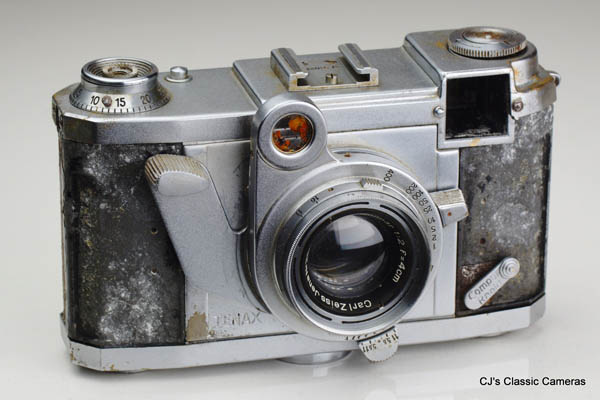
A very poorly Tenax II with interchangeable Sonnar 40mm f/2 lens and Compur-Rapid shutter, but in need of a new coat. I am not sure how it happened, but the metal in some areas had turned into white powder, which had expanded and pushed apart other metal bits. It says something about the build quality of Zeiss Ikon cameras that I managed to remove screws without issues and was able to clean and revive the camera to some extent. Note the holes in the metal next to the lens base, which is were the metal has been eaten away. I plan to fill the gaps and apply some fresh new leather, so at least it will be a reasonable display item.
Tenax I / Taxona
The Tenax I started production in 1939, but was soon interrupted due to WWII. In 1948 production continued in East Germany. In 1953 a version with fixed viewfinder and larger top housing was produced. It was renamed Taxona due to a name dispute with the West German Zeiss Ikon company.
The shutter release lever also cocked the shutter.
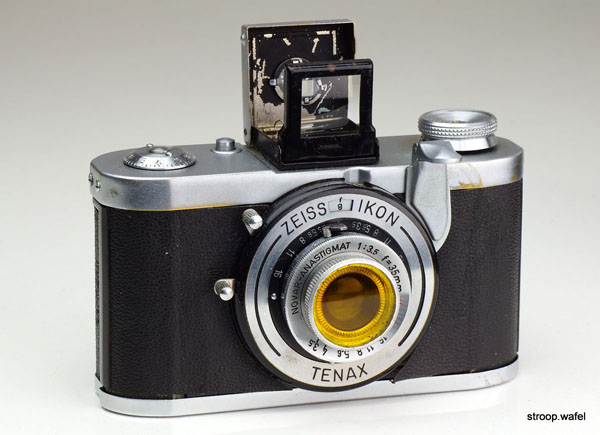
A Tenax I with Compur shutter (name not visible in picture).
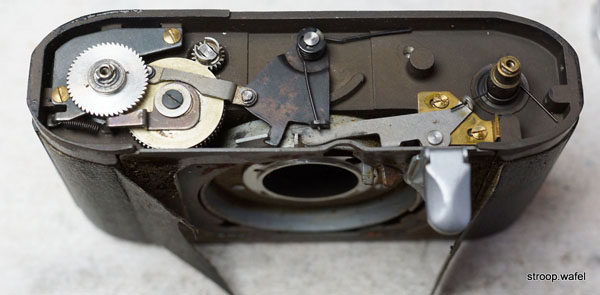
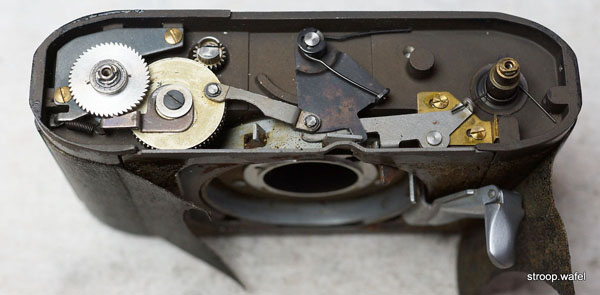
Shutter release and cocking mechanism of a Tenax.
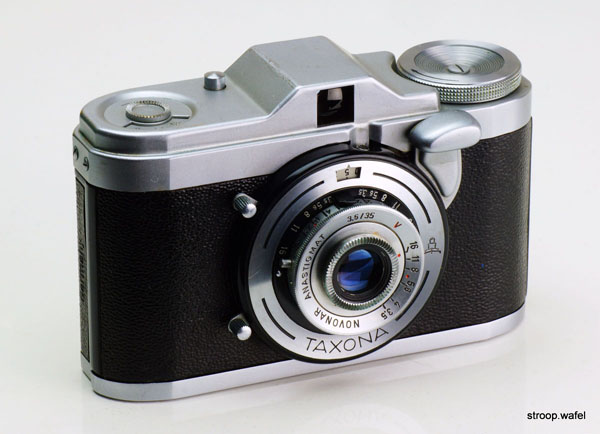
A Taxona with Novonar Anastigmat 35mm f/3.5 in Tempor shutter.
Contina II
Following the Contina range of folding cameras, which included the Contina I shown above, Zeiss produced a range of rigid-body cameras of the same name. The Contina II had a coupled light meter and viewfinder, the Contina I missed the light meter. The Contina III was essentially a Contina II with interchangeable lens mount, which used Pantar lenses that could also be used on some Contaflex models. Only the front-cell was exchanged, similar to the Kodak Retina 'c' lens system on the Retina IIIc and similar models.
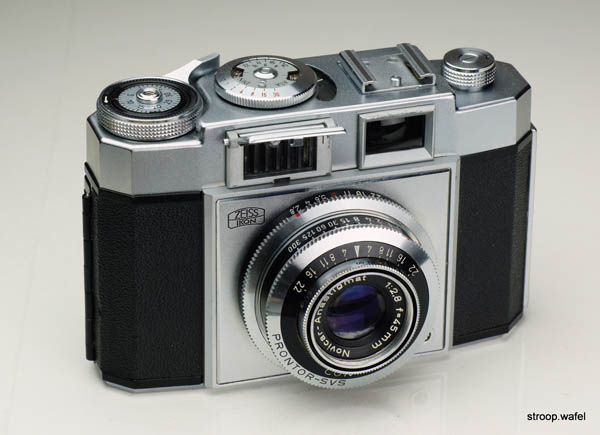
Contina II with Novicar-Anastigmat 45mm f/2.8 lens and Prontor-SVS shutter.
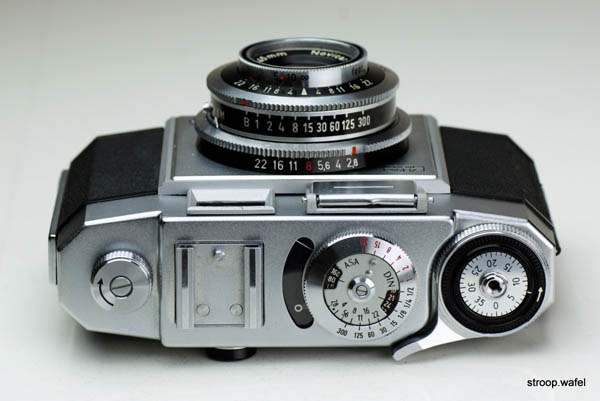
Contina II showing the coupled light meter.
Tenax Automatic
The name Tenax was recycled in 1960 for a completely different camera, but fairly impressive in its own right, for a point and shooter that is. As the name suggested, it had a fully automatic exposure mode driven by a large selenium cell. The light meter window at the top only served to indicate if the available light was enough for proper exposure. One could also set the camera to B or flash mode, in which case one could select the aperture setting. The shutter housing had zone focussing symbols as well as a distance scale. It was a stylish-looking and well-built camera with a good lens but limited options.
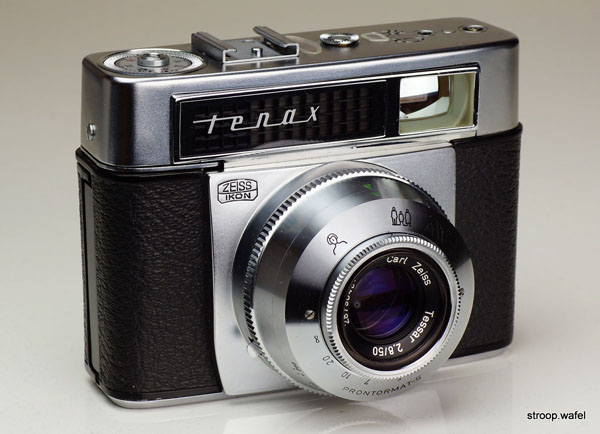
A Tenax Automatic with Tessar lens.
Contaflex SLR
The Zeiss Ikon Contaflex was Zeiss Ikon's first SLR camera, introduced ca. 1953, so much later than its East German strand (which made the Contax D and Pentacon F) and also a completely different design: a leaf shutter SLR. These are discussed in more detail elsewhere on this site (e.g., Retina Reflex, Ambiflex), but had several disadvantages compared to focal plane shutter SLRs, such as complexity of the shutter/aperture/mirror mechanism and limited range of interchangeable lenses due to restrictions imposed by the position of the shutter. The main benefit was flash synchronisation at all speeds, but probably not something the amateur photographer was overly worried about. So none of the models ever reached the popularity of focal plane SLRs.
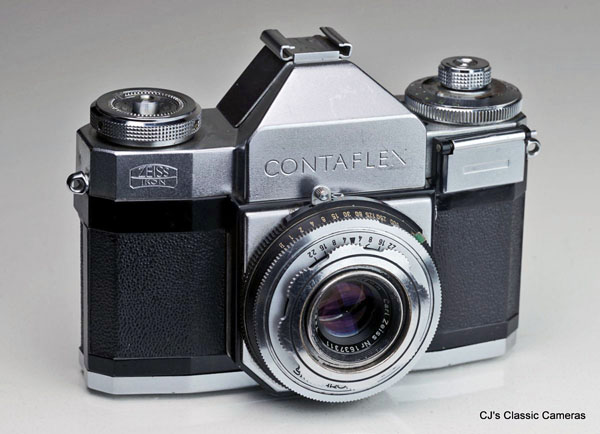
A Contaflex II with fixed Tessar lens and selenium lightmeter (which was lacking on the Contaflex I).
The Contaflex was very much recognisable as a Zeiss Ikon product due to the large Contax-style wind knobs. It was available with fixed lens as well as interchangeable lens mount , although in a very limited implementation, like the original Retina Reflex, with interchangeable front group only. Some were equipped with lightmeters.
Note: the original Contaflex was a pre-war 35mm TLR, a completely different camera of superb quality.
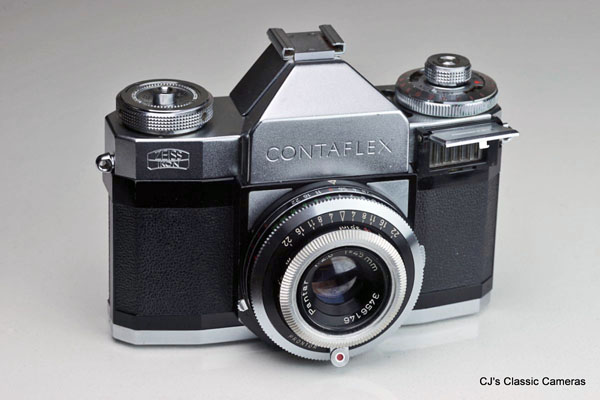
A Contaflex Beta, which had a Zeiss Pantar 45mm f:2.8 three-element lens with interchangeable front element, so that it could be converted into a wide angle or telelens. As you may have guessed, there was also a Contaflex Alpha, which did not have a lightmeter.
Contarex 'Bullseye'
The Zeiss Ikon Contarex was a marvel of a camera as well as a spectacular failure, which lead to the demise of Zeiss as a camera maker. It was designed to replace the Contax IIa/IIIa, Zeiss' state-of-the-art rangefinders, following the increasing popularity of SLR cameras. The Contarex was introduced in 1960 as the first fully automatic exposure SLR camera. This meant that aperture and shutter speed were both coupled to a lightmeter cell (the 'Bullseye'), so not automatic exposure as we understand it today - one still had to set the aperture and shutter speed by hand. However, one could do this whilst looking through the viewfinder, in which a needle indicated correct exposure or not. This wasn't very different from how the Kodak Retina Reflex cameras already operated.
The camera was clearly aimed at the professional photographer, it cost a fortune and weighted a ton. To go with the Contarex Zeiss introduced a new series of lenses, most notably the f/2 Planar standard lens and the 35mm f/4 Distagon wide angle lens. The lenses did not have independent aperture control, as this was set by the camera body, again, not unlike how Deckel mount cameras such as the Kodak Retina Reflex and Iloca Electric worked. The lenses had a reputation of being amongst the finest glass Zeiss Ikon ever created.
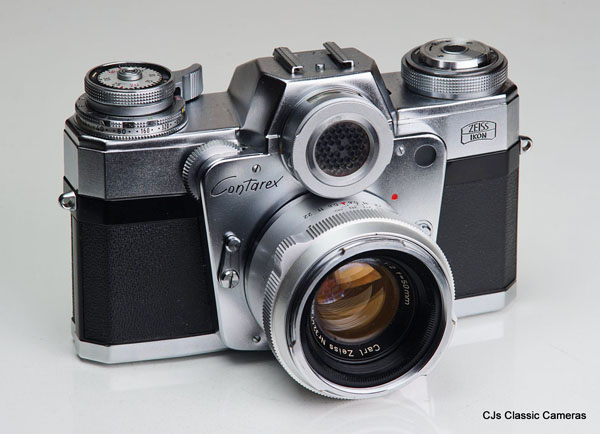
A Contarex 'Bullseye' with Carl Zeiss Planar 50mm f/2 standard lens.
So what went wrong? Apparently Zeiss had a lot of service requests on this camera. The exposure system had a flaw, it worked by reducing the light on the lightmeter cell by means of an iris, which matched that of the lens. The problem is that this reduced the effective size of the cell to the point it became nearly useless at small apertures. The camera was extremely complex and repairs were difficult. It was heavy and looked old-fashioned. It probably was a combination of all these things. The camera sold, but not well. Had it not been for the reputation of its lenses it would probably have been worse. In the end Zeiss Ikon produced several more models, including with more reliable CdS meters, but they never received great following.
To give credit where credit is due, the lenses were gorgeous. They still look modern today, the focus ring runs lovely and smooth, and they had a very close minimum focus distance for lenses from that era. The only quirk perhaps was the use of a bayonet style filter ring, great for rapid filter change but it made it tempting to try to mount the lens the wrong way around when in a hurry...
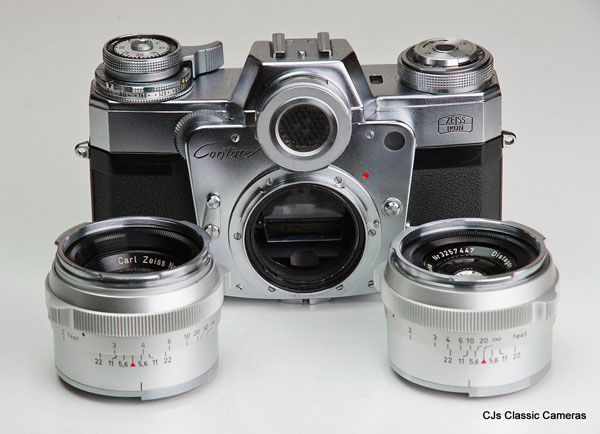
Carl Zeiss Distagon 35mm f/4 (right) and Planar 50mm f/2 (left), a pair of great lenses and still fun to use today if one doesn't mind manual focus (and why would you?). The only drawback is the lack of an aperture ring, so to use the lenses on a modern digital camera one needs an adapter that has an aperture control lever. On the other hand, this also makes it possible to design an adapter with automatic aperture control. The Metabones website is hinting that they are making such 'smart adapters' but it is unclear if this applies to the Contarex adapter. I wish it were true!
Ikonette
When scrolling down this page and seeing all the chrome and black leather, this camera was probably not what you would have expected to find. Alas, even the once mighty Zeiss Ikon succumbed to plastic cameras and cheap mass production. But let's not be too harsh, not many could afford the expensive high-end cameras Zeiss made, so they brought out a range of consumer cameras, of which the Ikonette is the most extreme example. It was actually not a bad camera and it did stand out. The most interesting aspect was probably the large lever at the front which was used to wind the film and which would automatically cock the shutter, but also doubled as a shutter release activated by a gentle push.
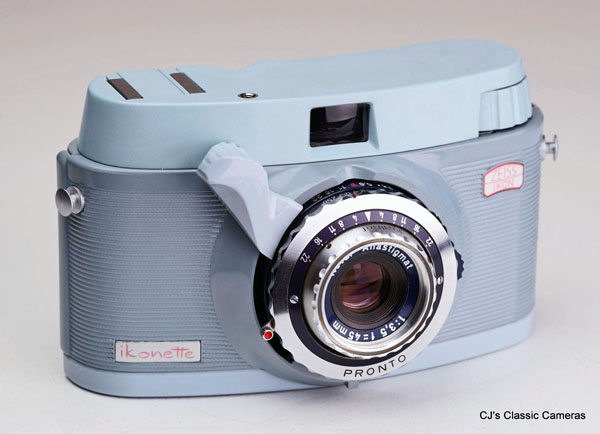
A Zeiss Ikon Ikonette. This example is distinctly blue, which is different from most other examples I have seen, which are generally sort of ivory or light green. The pink lettering of the name 'ikonette' is also different. It has been suggested this camera was aimed at the female market, and I guess that was certainly true for this variant.
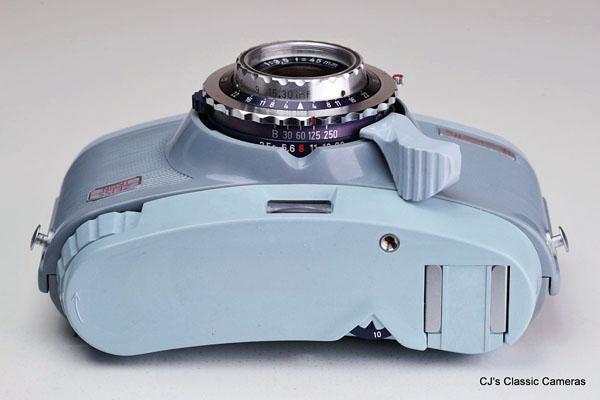
Top view of the Ikonette. Note the distinct curved shape, but this was purely ergonomical, as the film frame was in fact straight.
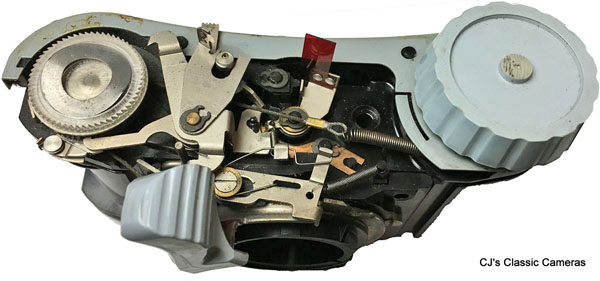
Ikonette with the top and front removed. The wind and shutter release mechanism wasn't working quite right on this one, hence the disassembly. The inside certainly doesn't have the high-quality components were used to with Zeiss, but it does the job. Note the small red plastic tab, which blocks the viewfinder until the shutter is cocked.
Movikon 8
This camera is a bit of an unusual departure from my side, as it is a movie camera, not a still camera. When my wife saw it her face filled with dread, fearing that this would be my next collecting adventure. When I told her that this camera came with a lot of regular cameras she was only half convinced, especially when I right away started looking for movie projectors. Because the amazing thing is, you can still use these! Yes you can buy 8mm film and get it developed, and play it on 8mm projectors of which there are plenty available on various auction sites.
Now you might say, are you sure this is a movie camera? It doesn't look like one? And that is true. Zeiss Ikon decided to design a movie camera that could be held as a still camera, because they thought it would be more stable to handle that way. Perhaps they thought it would make the transition from film easier for the avarage amateur photographer. And they were right to some degree. The Movikon certainly wasn't a failure, and they produced a range of different models. But the idea didn't really catch on, and movie cameras stayed the way they had been: tall and narrow, not wide and short.
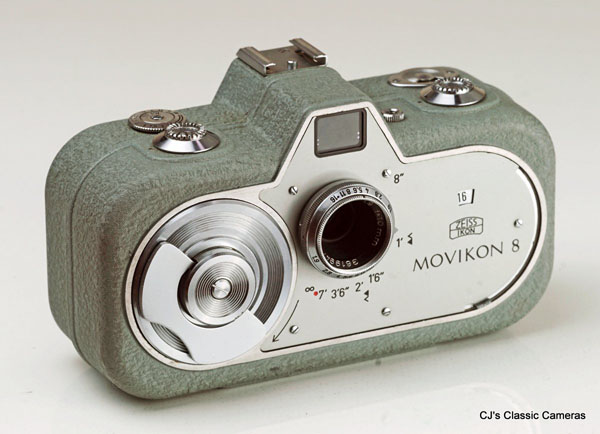
A Zeiss Ikon Movikon 8 with 10mm f/1.9 Movitar lens. This is a later model with multiple speeds up to 48 frames/second (standard was 16 fps). As far as I am aware movies were always projected at 16 fps, so faster recordings would essentially be shown in slow motion. One could also take single shots, useful for making animated movies. Note the large wheel on the front, which was used to wind the spring motor, good for about 30s of continuous filming.
8 mm film was an interesting concept. It was 16mm wide (indeed, made from 16mm film) and double perforated. During filming, only the top half of the film strip was exposed, and once finished the spools were swapped around so that the film was essentially rewound, during which the other half was exposed. After developing the film was split lengthwise through the middle and the two strips were spliced togther resulting in one long 8mm film.
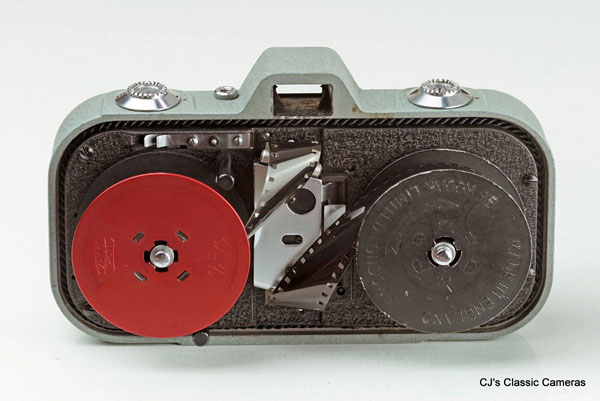
Interior of the Zeiss Ikon Movikon 8 showing the film spool arrangement and the complex shaping of the film needed to allow this arrangement. It works fine though, but it makes swapping the spools to reverse the film a little daunting.
Zeiss Ikon ZM rangefinder
The name Zeiss lives on, of course, as giant in lenses and optical components, but they are no longer involved in the camera business, and haven't been since the 1970s, with one exception: the 2000 Zeiss Ikon ZM rangefinder. The addition of the 'Ikon' part is notable here, as Zeiss no longer uses that in its branding. And Zeiss didn't actually make the camera, it was manufactured by Voigtlander, and no, not the German company, but the Japanese company Cosina that bought the name and produced the Bessa rangefinders, including the Bessa-L elsewhere on this site. Unsurprisingly, the Zeiss Ikon ZM shares characteristics with those, but is clearly superior, and closer to its Leica brethren. It has a fantastic build quality, a fabulously bright and clear rangefinder, and all controls are smooth but precise.
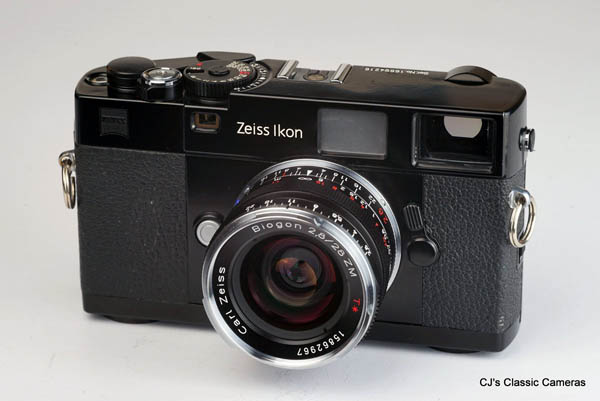
A Zeiss Ikon ZM with Carl Zeiss Biogon ZM 28 mm f/2.8 lens, where ZM stands for Leica M mount by Zeiss.
It is perhaps a little ironic that the ZM has a Leica M mount, considering Zeiss Ikon's previous rangefinder range, the Contax, had a different mount specifically designed to be different from the Leica mount, and quite succesfully so since also Nikon adapted this design for the Nikon S range. But clearly times have changed and the Leica M mount survived whereas the Contax mount did not. Indeed, the ZM feels much more like a Leica camera than a Zeiss camera, and the controls are largely located where you'd expect to find them on a Leica M rangefinder. All in all, this Zeiss camera is basically a hommage to Leica, perhaps trying to better it, but in historical context, mostly an admission of defeat of one German giant by another.
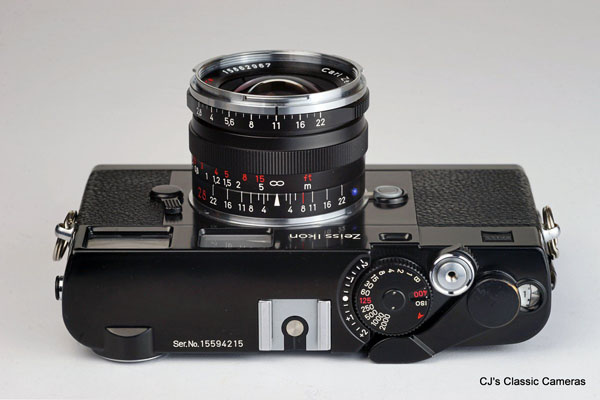
Top view of the Zeiss Ikon ZM, showing the neatly laid out controls, clearly inspired by that other make of Leica M mount cameras: the Leica M range itself.
|

